

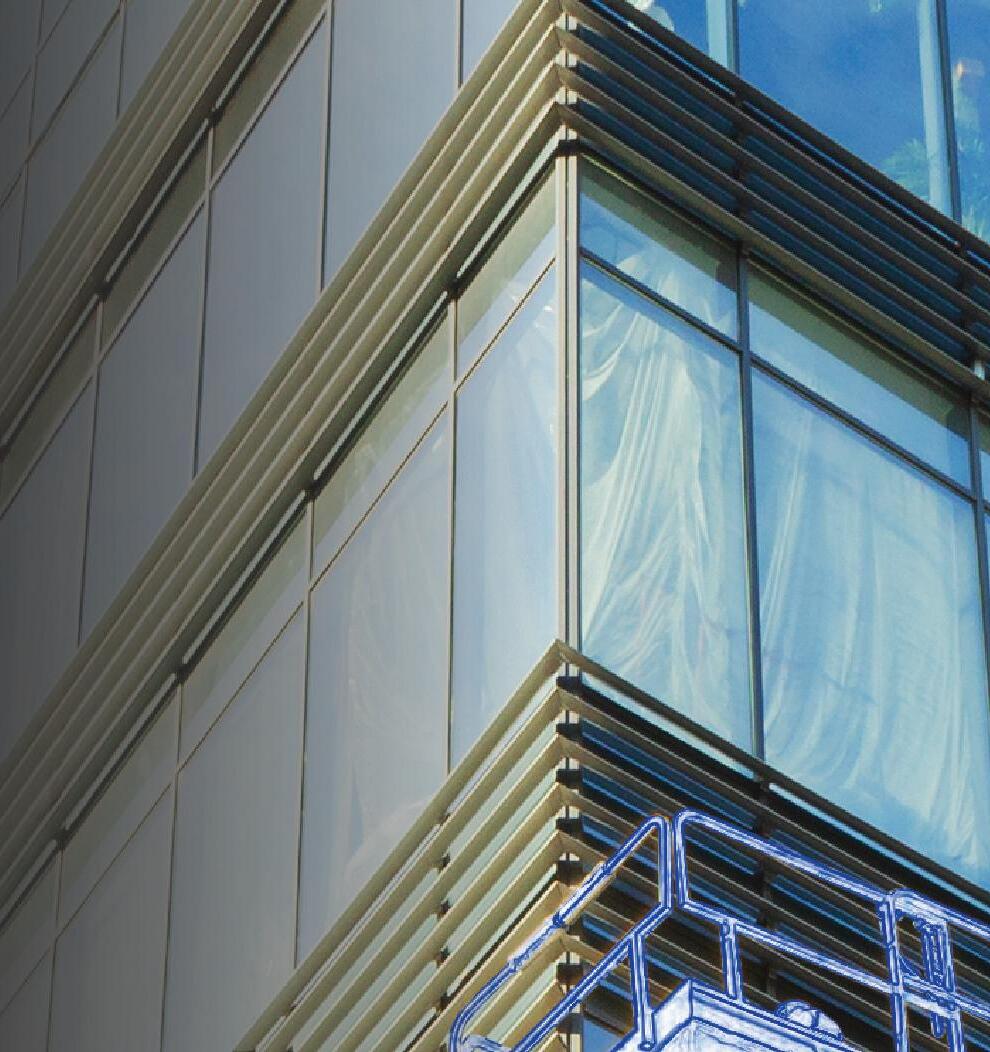
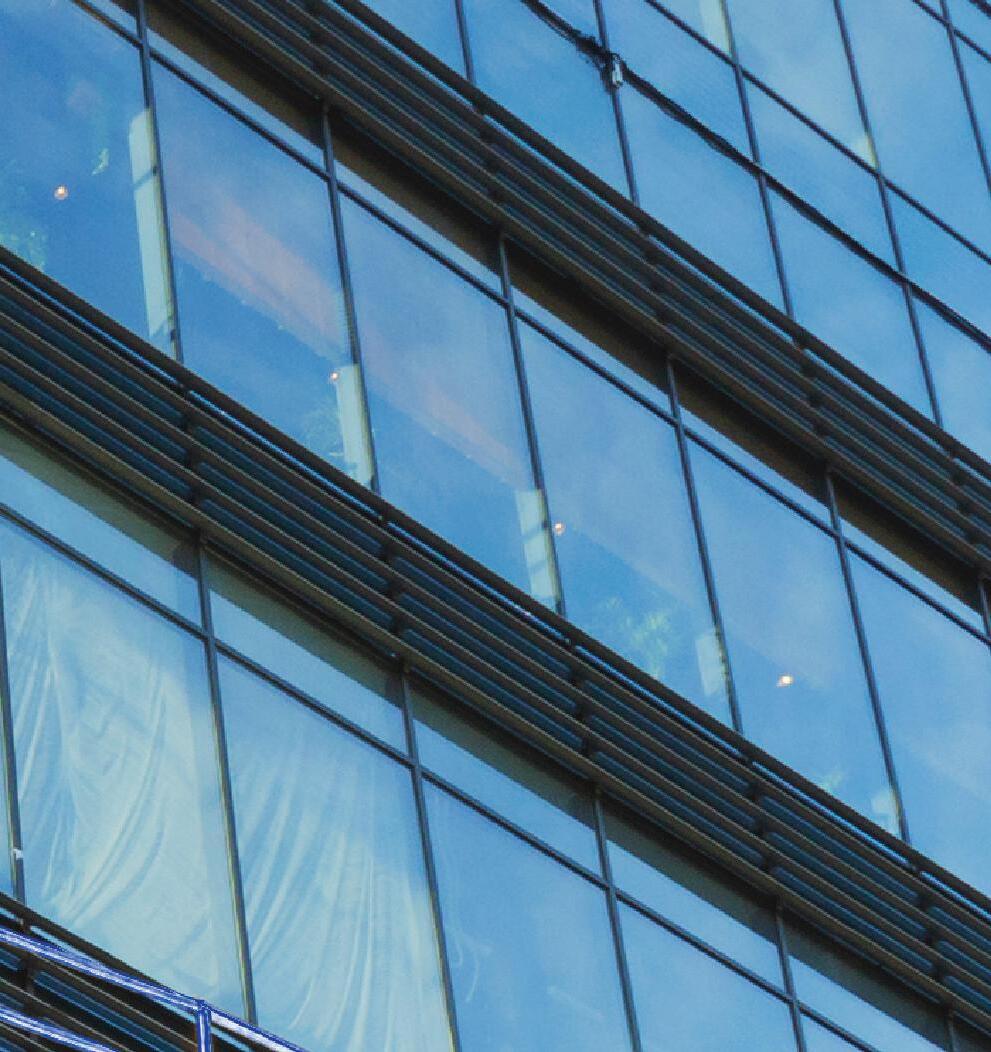
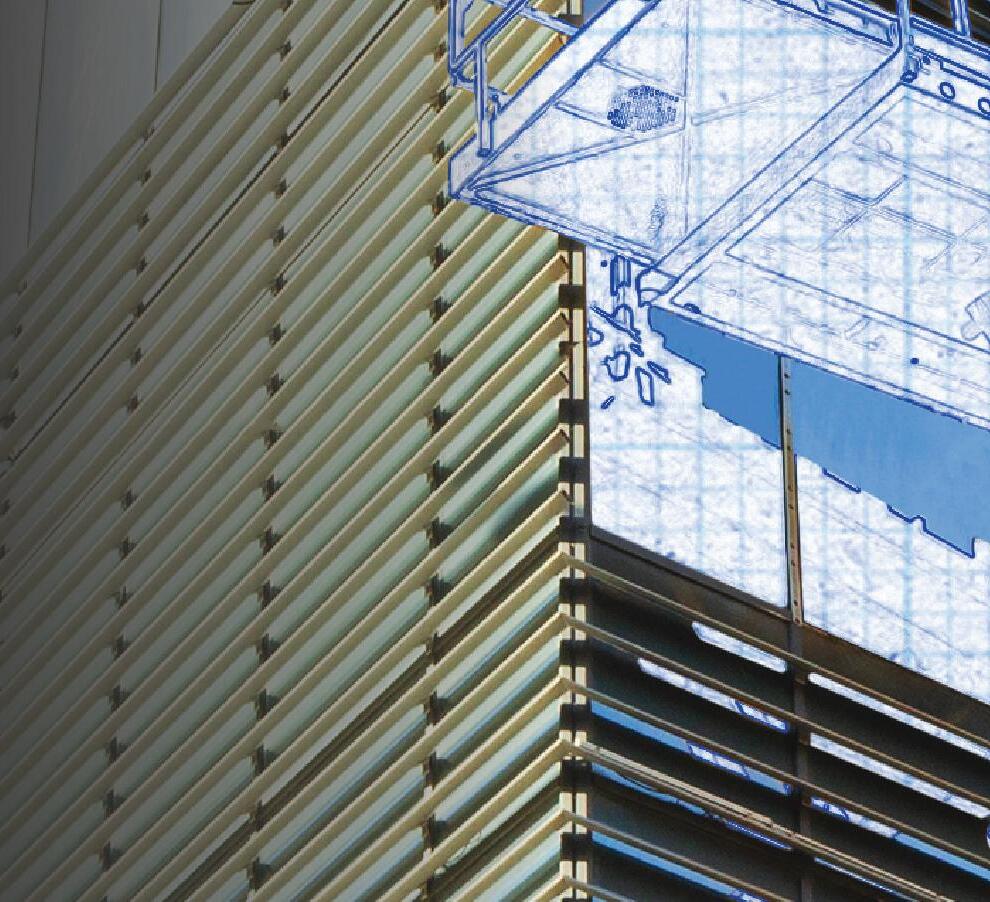








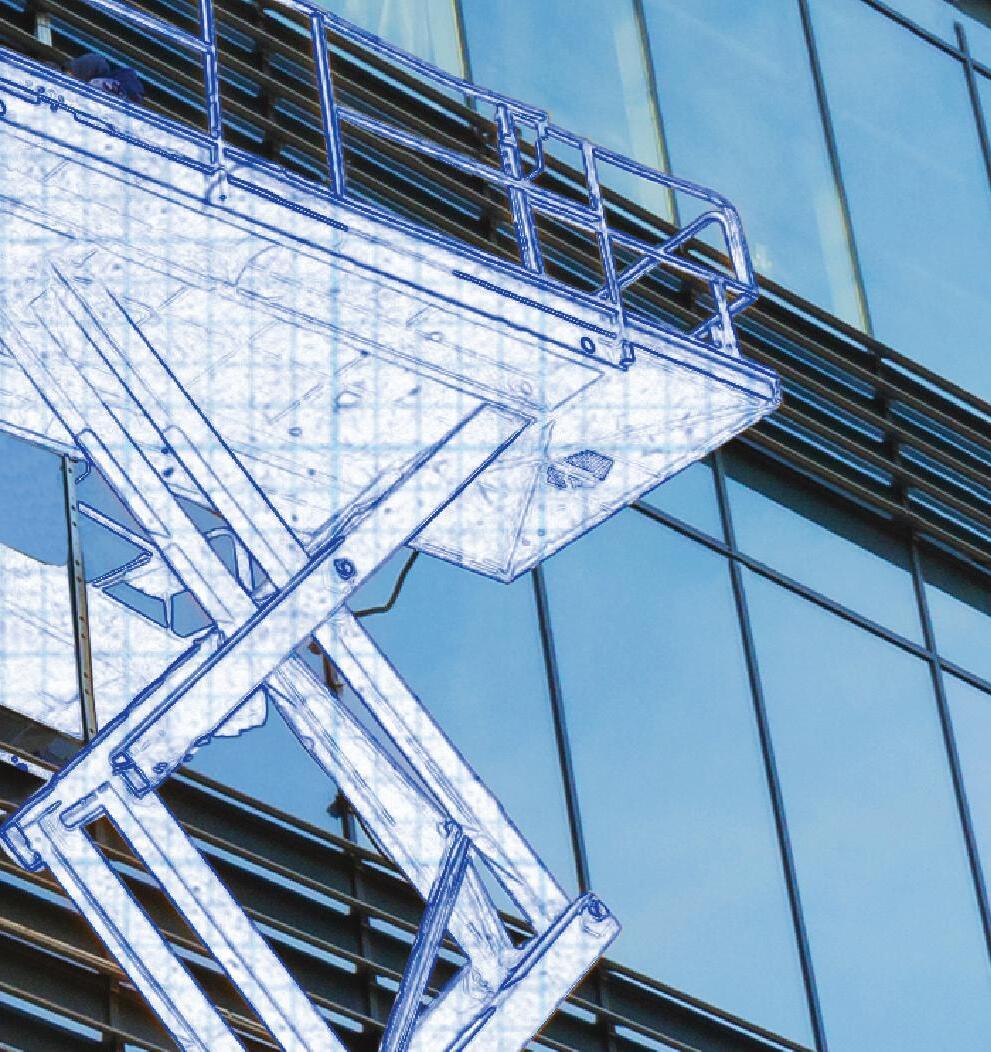

Experts debate whether engineers can completely remove safety hazards for the powered access industry.


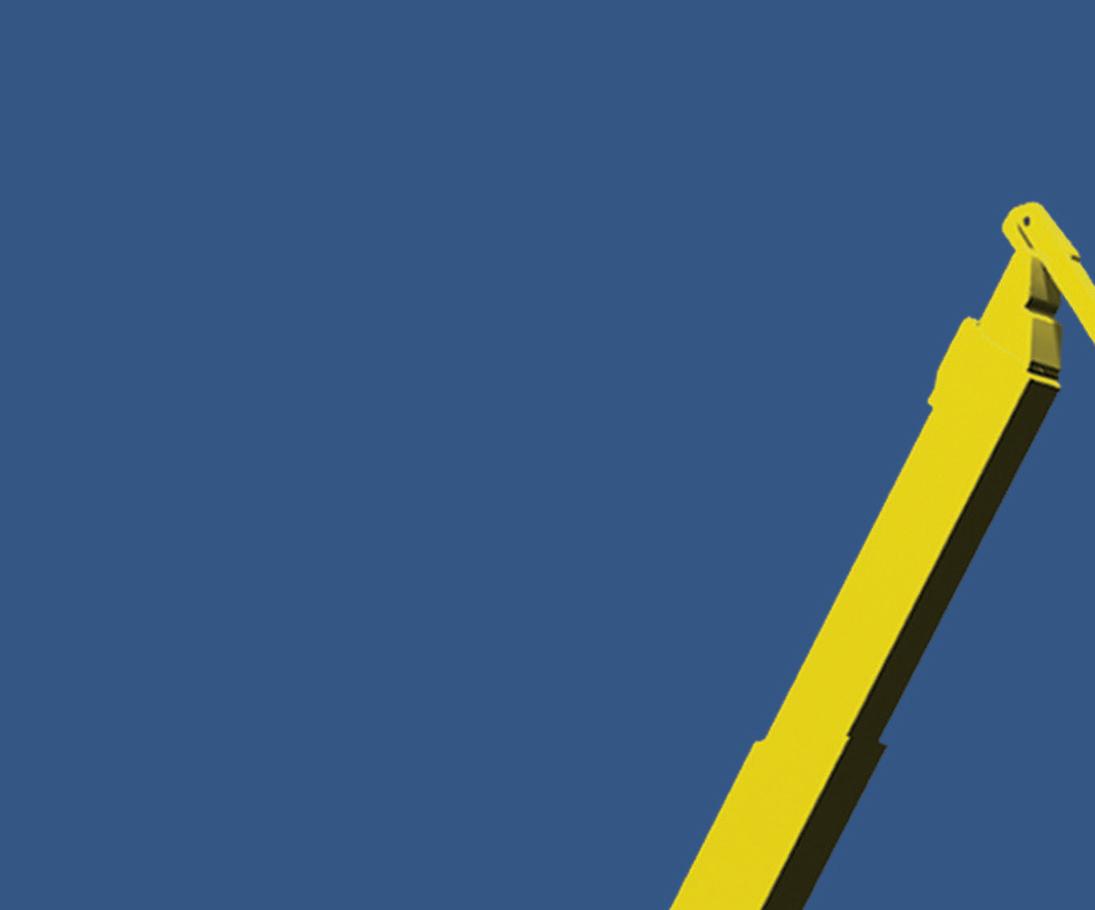



Life is full of shortcuts. But operating mobile elevating work platforms without properly trained, tested operators is a dead end decision. Train right. Insist on the PAL Card as proof. A valid PAL Card proves the holder has passed an approved and audited IPAF theory and practical test, compliant to industry standards. Find an IPAF-approved training center near you at IPAF.org or scan here
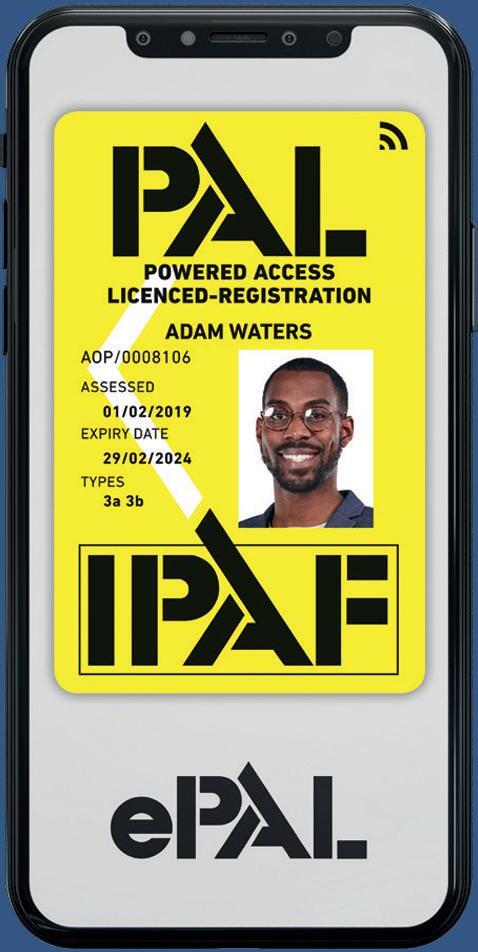


n the spirit of the International Powered Access Federation’s (IPAF) appreciation for the U.S. market, Elevating Safety takes center stage. It delves into crucial safety issues, emphasizing incident reporting and focusing on the U.S. market while providing insights on global data. IPAF advocates for proactive safety measures to prevent accidents, aligning with the safety standards pertaining to the U.S. The magazine previews the upcoming Working at Height Conference & Awards in Nashville, USA, highlighting the importance of safe MEWP practices and industry innovation within the American context.
As we reflect on our journey, we’re thrilled by the strides we have made and the path ahead. IPAF’s growth has been remarkable, with membership reaching 1,697 by the conclusion of 2023. Over 2.5 million operators now hold their PAL Card, a testament to the international recognition of our standards. Demand for training continues to rise, surpassing 200,000 trainees annually. Our eLearning platform has expanded, and the ePAL app has been downloaded over 500,000 times worldwide.
Safety remains our top priority, demonstrated by the impact of our Accident Reporting Portal. Our Global Safety Campaign, ‘Crushing Can Kill!’, addresses industry-wide issues such as entrapment incidents, sparking ongoing conversations and tailored training to reduce incidents around the world.
We extend heartfelt gratitude to outgoing President Karin Godenhielm, whose leadership has guided initiatives like Women in Powered Access, helping to drive diversity and professional growth. Additionally, our engagement in the US market has been reinforced by Elevating Safety magazine’s comprehensive coverage of safety concerns tailored to the American audience.
Other magazine highlights include updates on IPAF’s initiatives, market trends and wider activity in North America. We shine a spotlight on our new President, Karel Huijser, and share an update and insights into safety standards. The magazine features a telematics case study, showcasing the practical applications of technology in enhancing safety. I look forward to connecting with you all at the Working at Height Conference and Awards, and hope you enjoy this year’s edition.
Yours, Peter Douglas, CEO
International Powered Access Federation www.ipaf.org
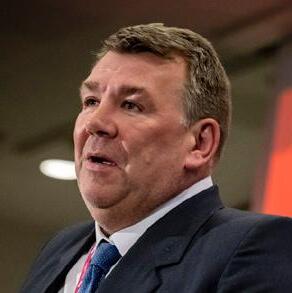
PS: IPAF is a not-for-profit organization created in 1983 (41 years ago) to promote the safe and effective use of MEWPs and MCWPs. Please visit www.ipaf.org for free resources and more information about us.
A panel of experts discuss the development and engineering of safety innovations in powered access equipment.
Investment in construction tech affects everything from the jobsite to the rental company office. The automation of manual tasks can reduce downtime on sites and help solve problems quicker.
The latest news and events from IPAF.
28
IPAF’s commitment to global accident reporting and safety remains as strong as ever.
It is critically important that IPAF and its members continue to play a key role in the development of voluntary consensus standards for MEWPs.
36
Q&A with Karel Huijser, IPAF President and General Manager for the EMEAI region at JLG.
39
Join IPAF today and elevate your business!
ORDER EXTRA COPIES OF THIS MAGAZINE FROM: IPAF USA
225 Placid Drive, Schenectady, NY 12303 Tel: 518-280-2486 | Fax: 518-689-6800 usa@ipaf.org | www.ipaf.org
IPAF HEAD OFFICE
Moss End Business Village, Crooklands, Cumbria LA7 7NU, UK info@ipaf.org | www.ipaf.org | Matt Brereton, editor
IPAF NORTH AMERICA MEMBERSHIP OFFICE
800 Roosevelt Road, Suite C-312, Glen Ellyn, IL 60137 Tel: 630-942-6583 | Fax: 630-790-3095 usa@ipaf.org | www.ipaf.org
IRONMARKETS
201 N. Main Street, 3rd Floor, Ste 350, Fort Atkinson, WI 53538-0803 800-538-5544 | Fax: 920-542-1133 | www.ForConstructionPros.com
Sean Dunphy, Brand Director – Construction | sdunphy@iron.markets Jonathan Kozlowski, Editor | jkozlowskit@iron.markets
IPAF Elevating Safety is published by IRONMARKETS. This material is intended to provide general guidelines for safety and best practice in the use of powered access equipment. Under no circumstances should the material be used as an exclusive source of technical and safety information. The publishers disclaim liability for any loss, damage, injury or cost incurred.
By Daniel O’Sullivan, Communications Manager, IPAF
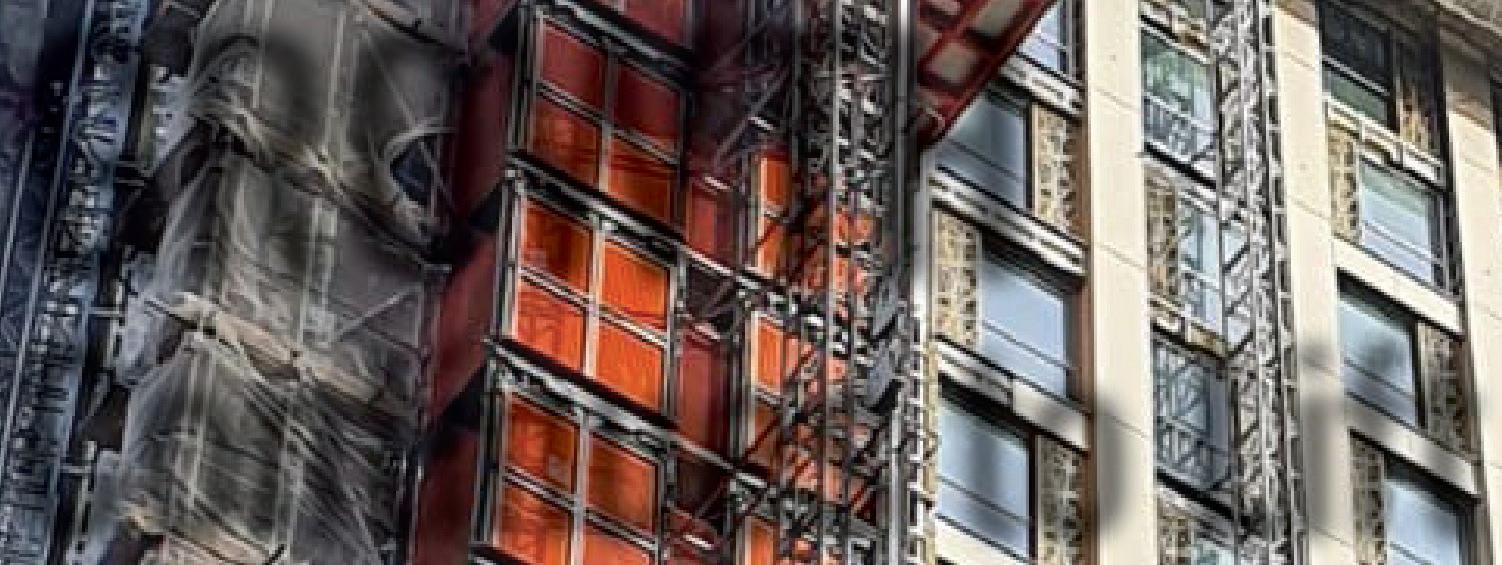
The U.S. rental industry thrived with strong growth in 2023. It’s now poised for continued expansion in 2024 and beyond.

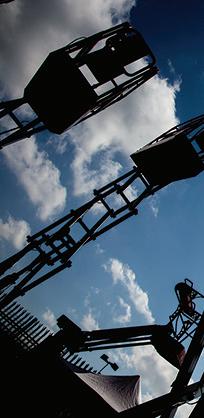
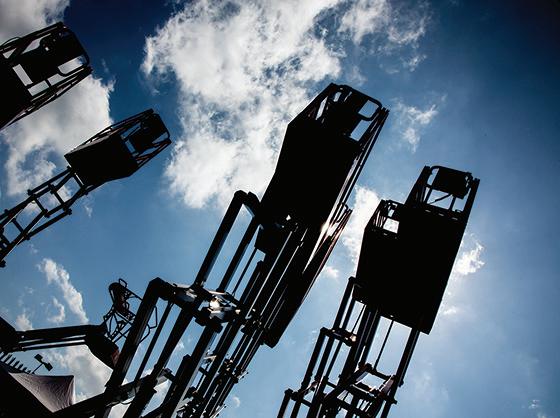

The U.S. rental industry, particularly in the sector of mobile elevating work platforms (MEWPs), has witnessed healthy growth in recent years, as revealed by insights gathered by the International Powered Access Federation (IPAF) in collaboration with the Global Consulting and M&A Firm, Ducker Carlisle, in the 2024 IPAF Rental Market Report – which assesses MEWP rental markets in the U.S. and around the world.
In 2023, the industry soared with a remarkable 10% rise in MEWP rental revenue compared to the previous year. This substantial growth was driven by a series of positive indicators, marking it as a standout year for the sector. Key among these indicators was the sustained high level of utilization, averaging at an impressive 73%. Such strong demand necessitated an expansion of the fleet to meet customer requirements, with estimates indicating an 8% growth to around 855,000 units.
Moreover, the value of fleet investments increased by 13% in 2023, reflecting the industry’s confidence and commitment to meet escalating demands. However, amidst this growth, inflation loomed, prompting a 4.5% increase in rental rates when averaged across the 50 states. Despite this, the industry remained resilient, sustained by high demand.
Now in 2024, the U.S. rental industry remains poised for continued expansion, albeit at a slightly tempered pace. Projections indicate that MEWP rental revenue is set to grow by an impressive 10%, propelled by a 5% increase in fleet size and an anticipated 4% rise in rental rates. Importantly, the high utilization rates that facilitated the sector’s success in 2023 are expected to remain stable, further bolstering revenue growth.
Furthermore, companies within the industry are committed to maintaining their current level of investment, with a projected 4% increase expected in 2024. This steadfast commitment underscores the confidence in the sector’s trajectory and its ability to navigate potential challenges on the horizon.
In conclusion, the U.S. rental industry, particularly in the MEWP sector, has experienced a period of remarkable growth and prosperity. The stellar performance witnessed in 2023 is set to continue into 2024, albeit with a slightly moderated pace. As companies gear up to meet evolving customer demands and market dynamics, the future appears bright for this vital segment of the economy, underscoring its resilience and adaptability in the face of changing circumstances.
For in-depth analysis of rental markets across the globe, the 2024 IPAF Rental Market Reports are available now. IPAF manufacturer, supplier, distributor and rental company members can apply for a free copy of the relevant report by filling in the form at www.ipaf.org/reports; non-members are able to purchase the report. p

By Jonathan Kozlowski, Editor, Rental Magazine
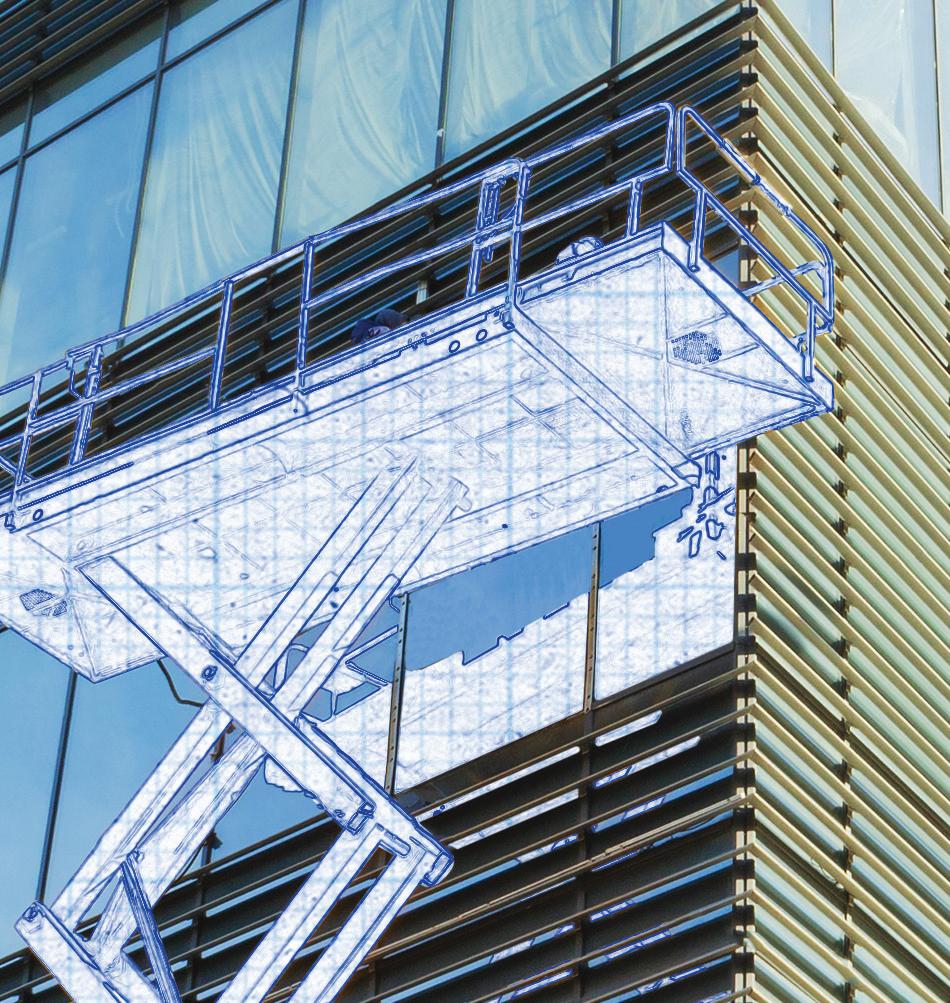




A panel of experts discuss the development and engineering of safety innovations in powered access equipment. The conversation starts with the question at hand: can safety hazards be eliminated via engineering and design?
Meet our panel:
• TJ Lyons, Certified Safety Professional Occupational Health and Safety Technologist and Construction Risk Insurance Specialist, of Lyonetics Consulting LLC (retired)
• Kevin Gildea, PE, Product Safety and Compliance Manager at Haulotte
• Brian Clark, Director of Product Support at Sunbelt
• Nicholas DeJesse, Assistant Regional Administrator at the Occupational Safety and Health Administration, Region III
• Tony Groat, North American Regional Manager at the International Powered Access Federation
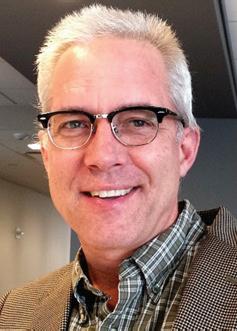
TJ Lyons
Certified Safety Professional Occupational Health and Safety Technologist and Construction Risk Insurance Specialist
Lyonetics Consulting LLC
Lyons: You can design out the majority of the risks…. I think there are certainly design interventions that we may be reluctant to do based on cost but should be done.
Groat: Engineering can significantly reduce risk and hazards but it is typically not possible to eliminate hazards entirely. Many potential hazards can be mitigated. This can include using failsafe redundancies, ergonomic considerations, and other safetyfirst principles. But there are limitations for engineering. There are unintended consequences that also come from some of the designs or protections that actually create another unique set of hazards that need to be taken care of. You do end up having environmental factors that are pretty hard to “engineer” out. There are technology limitations as well in lots of areas. And there’s the bottom line. There’s a wide range of availability for design solutions to take place. But when you’re looking at the hierarchical solutions, it always leaves areas where other things need to be involved as well.
Gildea: I would agree. I think instead of saying, “design out hazards,” we’re more talking about reducing risk to a tolerable level and if it can be reduced even further for some hazards. When you think in a certain context, there’s a diminishing return for additional efforts. For example, hydraulic safety. That’s maybe not the area to focus on from a design point of view because it’s gotten to the point where the mitigation measures are sufficiently mature. There are other areas that could use additional risk mitigations.
Rental: What do you mean by other areas?
Gildea: Areas that are either new or haven’t been explored, or the application of new technology in our industry. Collision avoidance is a good example. LIDAR sensors or different types of sensors that are used in the autonomous vehicle space were, 15 years ago, would be unthinkable to apply them to machines in our industry. Now it’s gotten to the point where you could apply them and there are ways to use them.
Clark: Load sense is another example. I’ve been in the rental industry for over 30 years, and I’m just thinking about how technology has changed over the years. And then we’ve reduced some hazards in MEWPs over the years. There’s always room for improvement as technology changes and as the cost of that technology gets used more. I always equate it to the auto industry. The construction industry as a whole sees what the auto industry does and then, a few years later, tries to implement a similar technology across the board.
Gildea: That’s my experience as well. You have suppliers to the auto or defense industry that developed products specifically for that industry. Now they’re looking for other markets and applications.
There are a lot of innovations and safety improvements that happened to machinery, mobile machinery that most people
wouldn’t even be aware of. For instance, the improvements in electronic controllers over the years, where you have much better ability to detect an open circuit or detect that the wrong current is passing through an input. Whereas that was maybe more specialized in the past, but now that’s common. There are a lot of improvements that come from other industries that you wouldn’t even know as an end user.
DeJesse: I think Tony may have said the one word: ergonomics. I look back, let’s say 25 years ago, and ergonomics was an important aspect of what was going on with injuries and illnesses, musculoskeletal disorders, and so on. With that, we came up with the solution, “Let’s fit the task to the person, not fit the person to the task.”
One great example of how design was implemented to help: we moved certain portions of a [production] line, especially with manual applications. We started doing more in the sense of stretch and flex, lifting procedures, and musculoskeletal risk factors. We’ve seen a reduction in musculoskeletal disorders over time.
Another great example, and I know this doesn’t happen
The question can be misleading within the scope. If the question is implying that ALL hazards can be designed out, engineering can significantly reduce risks and hazards, but it is typically not possible to eliminate all hazards entirely; many potential hazards can be mitigated. This can include using fail-safes, redundancy, ergonomic considerations, and other safety-first design principles.
Limitations of Engineering: Unintended consequences where changes to one aspect of a system might introduce new hazards elsewhere.
Human Factors: Human error can contribute to hazards, and while engineering can mitigate these risks (through training, ergonomics, etc.), it cannot eliminate them entirely.
Environmental Factors: External factors like weather, earthquakes, and other natural events can create hazards that are difficult to engineer against completely.
Complexity: As systems become more complex, the risk of unexpected interactions and failures increases, which can introduce new hazards.
Technological Limitations: The current state of technology might limit the extent to which hazards can be mitigated or eliminated.
Resource Constraints: Budget, time, and other resource constraints can limit the extent to which safety features are implemented.
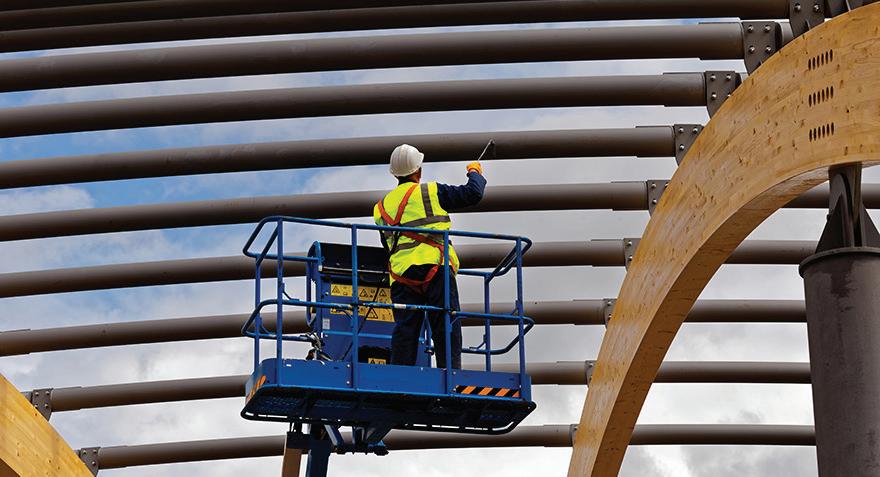
in lifting, but look at our bloodborne pathogens standard and the implementation of engineering devices, to where after an individual an injection—the needle now retracts into the vial itself so now no one could get punctured by that used needle. I think the engineering is out there. But some of the gentlemen actually said, some hazards we can mitigate, or at least, mitigate as low risk as possible. But they are still going to be present. We’re still going to have to put in effective controls to ensure people don’t get hurt or get killed.
Rental: On the contractor side of things, how have you seen these ideas affect the jobsite?
Lyons: A great example is in table saws by a company called SawStop…when it touches skin, it shuts off instead of cutting your finger. What we started doing is putting into the contract: “If you’re going have a table saw, it’s going to have technology that will protect your fingers similar to SawStop.” Rather than waiting for a regulation…you put it in the contract. If it’s purchased upfront, you don’t have to fight about it later.
Typical of what we’ve done in the industry is after somebody cuts their finger off, we say “Hey, why don’t you use one of the saws that doesn’t cut your fingers off?” This is as simple as it gets. If you put in a contract, you eliminate all those conversations about who’s going to pay for it, etc. Because it’s already put in place. It’s prevention at its best.
Rental: How else has the industry “designed out” hazards?

Tony Groat North American Regional Manager
The International Powered Access Federation
Groat: I think there’s a phenomenal number of those. We talked about overload protection. We ended up having simple things [like] emergency stops, proportional controls, interlocks, selfleveling systems, a full scope of secondary guarding systems, anti-crushing devices, the technology is increased where we now have sensors that will mitigate collisions, accessories are out there like pipe racks that keep people from overloading the guardrails, anti-collision systems, auto-leveling systems on machines. The list can go on and on. I think that there have been more technological changes in equipment in the last 10 years than probably 20 years prior.
Rental: What are the big safety features of lifting equipment? What are the latest changes?
Clark: One of our larger contractors on large jobsites like data centers and places like that. The most common thing, believe it or not, is simple: perimeter lighting. You’re putting lights on the four corners of the MEWP or scissor lift, so you put a visual on the ground so when people are walking around or people are operating the lift they’re aware of their surroundings and aware of this, I call it “a bubble of safety,” if you will, around the machines. It’s a growing market. We’re renting hundreds and hundreds of these a month. We are working with our suppliers so they have solutions where they can deliver it on the machine integrated with the MEWP.
Groat: What about telematics?
Clark: We’re heavily in telematics. For every machine we get today from any manufacturer that offers telematics, we’ll integrate their solution. That helps us with diagnosing problems with the machines. We can see how the operator is using the machines but particularly the machines that have load sense we can see how much weight is in the basket. We can see what’s overloaded so if we get a service call like, “Hey, my machine won’t raise / my machine won’t lower,” we can see [that] they’ve exceeded the 500-lb. capacity, as an example. That technology has helped us with reducing our service calls for sure.
Groat: It seems like a light switch was flipped in regard to moving forward toward full electric machines. Why is that? Is that technology driving that change?
Gildea: There’s a lot of reasons. Obviously, there’s the environmental side of getting away from fossil fuels. If you have an electric machine, you have a choice of how you’re going to
get the power to it and it opens things up in the future. The basic building block is an electric machine. If eventually hydrogen fuel cells become common, for example, you need the basic block of having an electric machine in order to get to that. If you want to have it powered by a diesel or a gas engine, you could still do that and that would be another alternative power source. I think that was one of the big drivers.
The benefits that come with having no direct emissions. If you’re in an enclosed building, you don’t have to worry about the exposure of fumes while you’re working at height.
Another advantage is the controls that go with electric machines. The electronic controls for drive systems have come so far over the years and allow very fine control of movements. Again, that’s a lot driven by the auto industry. I remember 20 years ago, being in a different industry and being a member of SAE (Society of Automotive Engineers)…the continuing education classes were just coming out about designing for hybrid drive trains, and electric motor theory and electric motor controls. They were the first classes that were training engineers on how to work with a non-mechanical drive train. Now it’s progressed and you can apply it to our industry because it has this history and background to it.
Clark: We were an early adopter of the JLG’s DaVinci all electrics (scissor lift). Being a fluid-free machine there are some applications for sure that the customers are wanting. We picked up “electrical efficiency” with those machines. Depending on the application, they can go a week without charging—which is another service call from our customers, they don’t charge them at night when they leave in the day. A more efficient machine is beneficial for the industry for sure.

Kevin Gildea PE, Product Safety & Compliance Mgr. Haulotte
Gildea: In general, making the transition from gas and diesel power to electric at first, the battery technology didn’t provide the energy storage you needed. OEM’s beat up on hydraulic suppliers, on other components and system suppliers to get more efficient. In the past, you didn’t focus on 1 or 2% losses that were coming from your hydraulics for example, but when you were making that transition to electric those small numbers add up and made a difference. Over time, machines became more efficient. Not just from the batteries and motors, but from other systems where you had done the work to gain efficiency improvements.
Clark: I will say there’s a movement to go from hydraulic drive to electric drive. We’ve been a proponent of that for a very long time, we’ve worked with our manufacturers to ask them
I believe there ARE increasingly more design solutions being offered every year. Whether driven by changes in design standards or simply the ongoing drive for innovation and differentiation between manufacturers—there are new design solutions every year. Perhaps that they may not be on all equipment or targeted niche uses— they may not be as visible to all users.
There may also be hesitation to be the first to try something new, wait for the bugs to be worked out or cost to come down, so waiting for market acceptance may slow manufacturers attempting to innovate for the sake of innovation. Developing something because you can is less effective than being driven by market demand.
Over the years, there have been many examples of engineered solutions introduced in the MEWP industry:
• Pot-hole protection
• Overload protection systems
• Emergency stops and cut-outs
• Proportional controls
• Interlocks
• Self-leveling systems
• Secondary guarding systems, including proactive ultrasonic sensors to mitigate collisions
• MEWP accessories
• Pipe racks
• PFP anchorage alarms
• Proximity sensor
• Anti-collision systems
• Auto levelling
• Access X-tra Deck (mid-rail)
• Full electric: no hydraulic spills
• Compact lifts to newer drivable heights, more options and versatility.
• Telematics: remote machine diagnosis, predictive maintenance
Sometimes solutions are not seen because manufacturers do not hear or see the needs customers want or need. A great example is the recent introduction of access decks. Users have long been modifying MEWPs with homemade decks on the midrails but we have pointed to the rules NOT TO DO THAT, rather than addressing why they are doing that and questioning how we can assist them in doing it right.
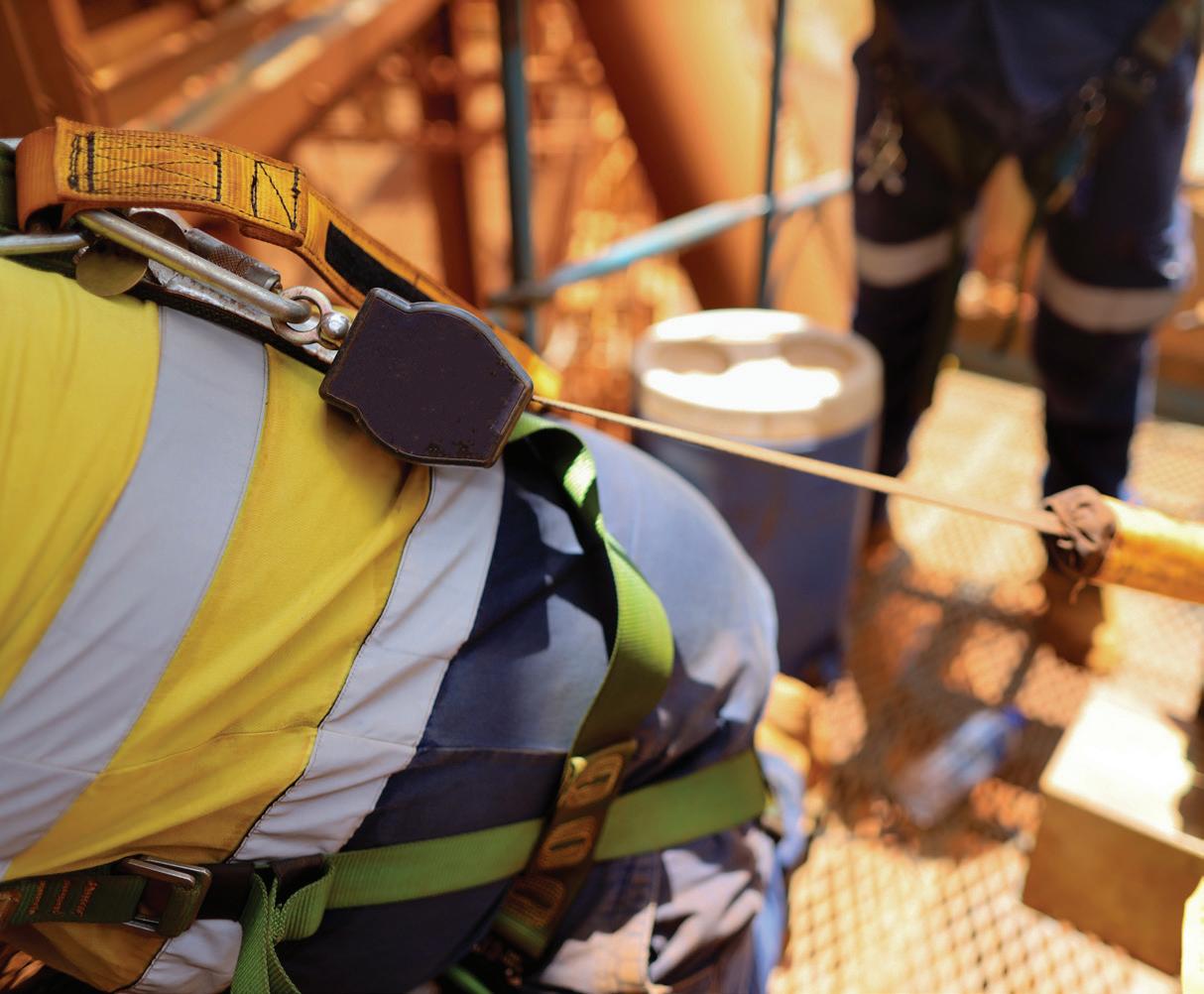
to look at this and implement that. That kind of spun out of another manufacturer who was an early adopter. We could see the efficiency—it’s hard to calculate—but we could see, the less downtime calls the service calls for batteries.
Gildea: To connect that with reducing or mitigating risks, think about lithium batteries. When those first started to come onto the scene, and they were available for use in our (Haulotte) machines we saw that we could design them in, there was a big focus on safety. They’re not like lead acid batteries. There are certain additional safety systems that you need. You need a battery management system (BMS) to monitor Over temperature, Under temperature, Overvoltage, Undervoltage, etc. These are extra safety systems that didn’t exist before, that you didn’t have to watch before, but are needed because lithium batteries have different risks. I think that’s, maybe, one thing that was a big focus on the OEM side and the design side that maybe wasn’t as well known to end users or the industry as a whole. That was an area where it was a big effort to mitigate the risks as much as possible by the design of the machine itself.
Lyons: It’s being recognized in the field. We’re doing work for the Army Corps of Engineers right now and lithium batteries have been added to their manual of special storage containers in construction. Now, typically, they’re charged outside of the building, especially wood frame construction. [For example,] we got rid of ladders…because lifts are three times more efficient. But then lifts started traveling off the edge of buildings. So, there are some consequences to the interventions we make.
I did want to add that it’s not just the equipment. Many larger companies, let’s say they spend 300 work hours putting up a series of piping in a facility, they make that off-site now in a
workhouse. They raise this modular assembly in about 4 hours. Not only can we make safer equipment, but we are reducing the excursion hours that we have to do the work at height.
If you build “this” on the ground and stick it up into place, and move on to the next building, [that will] dramatically reduce injuries or incidents because they don’t have those exposure hours.

The Occupational Safety and Health Administration, Region III
DeJesse: I think Tony may have said the one word: ergonomics. I look back, let’s say 25 years ago, and ergonomics was an important aspect of what was going on with injuries and illnesses, musculoskeletal disorders, and so on. With that, we came up with the solution or saying, “let’s fit the task to the person, not fit the person to the task.”
One great example how design was implemented to help out: we moved certain portions of a [production] line, especially with manual applications. We started doing more in the sense of stretch and flex, lifting procedures, and musculoskeletal risk factors. We’ve seen a reduction of musculoskeletal disorders over time.
Another great example, and I know this doesn’t happen in lifting, but look at our bloodborne pathogens standard and the implementation of engineering devices, to where after an individual an injection—the needle now retracts into the vial itself so now no one could get punctured by that used needle. I think the engineering is out there. But some of the gentlemen actually said, some hazards we can mitigate, or at least, mitigate as low risk as possible. But they are still going to be present. We’re still going to have to put in effective controls to ensure people don’t get hurt or get killed.
Rental: Why are not more design solutions seen in the market?
Gildea: I don’t wholly agree with the premise that they aren’t out there. As mentioned before, there’s some design solutions and risk mitigations that are implemented in machines that aren’t necessarily apparent to the end user.
Like the lithium battery example. A lot of things were implemented when that technology was used that are definitely improvements, and definitely risk mitigations.

Brian Clark Director of Product Support Sunbelt
Clark: That’s the continuous improvement side of the business. That’s not always seen by the end user. We have a lot of data from our large fleets. We work with our manufacturers. We share our
breakdowns, our service calls, our details on parts consumption on the machines that are 7 and 8 years old. They’re seeing the data from that, and we’re working with the manufacturers in the background to make the machine inherently better, which will hopefully make it inherently safer.
Gildea: That’s a good point, Brian, anybody that works on machines over the past 20 years knows about the improvements that have been made.
Groat: I have two thoughts on why would be hard to see some things moving along. One of them is the inherent risk of being the first to try something. I know as a buyer of this equipment years ago, you didn’t want to be the first one to go out and get the new technology, because there are always bugs with it.
Innovation has cost. Innovation has inherent failures and trying something that you think is going to be the next best thing in the world and it goes over like a lead balloon in the marketplace. There’s a lot of cost to innovation—you want to make sure that that innovation is going to be successful. I think the risk to being innovative, can be one area.
Another part of it is sometimes you have a tendency to place
the problem in another area of saying that we are not going to address it this way, it should be addressed not through innovation, but through administrative controls. I’ll give you an example of one that it’s probably the most recent. For years, we ended up having people in the field going over there and putting some type of device across the mid rails to raise their height to get
Safety solutions can BOTH increase and decrease a manufacturer’s liability.
In general, a design solution’s impact on liability depends on multiple factors, including the design’s effectiveness in mitigating risks, the adherence to safety standards, the communication of safe usage, and how the solution is implemented. A manufacturer’s liability depends on various factors, including safety, testing, documentation, training, design complexity, integration, and adherence to industry standards. By addressing these factors carefully, manufacturers can reduce liability and minimize the risk of legal claims.








up higher into areas that the guardrails wouldn’t allow to get up higher in there. And we kept going, “no, don’t do that.” It wasn’t till recently that we went over just said, “Why are they doing this” and “How are we going to help them solve that.” Sometimes, I think, we don’t necessarily hear or see what the users of this equipment are experiencing and are more reflective on historical approaches: “Don’t do that,” “Find a different piece of equipment,” and “Our equipment doesn’t do that way.” I think that we’re becoming much more innovative as an industry and attuned to that. TJ, I know that you, as contractors, you went over there really tried to look at those things. What are your thoughts?
Lyons: There are two big barriers. Number one is, if you have a fleet of equipment and spent half a million dollars for some of the best scissor lifts in the world 3 years ago, you’re not going to buy more scissor lifts even if there’s an innovative product out there because you already have scissor lifts.
Same problem we had when you move from ladders to scissor lifts. I was in New York once to talk to one of the largest electrical contractors and asked, “How come you’re not using lifts here?” He says, “Oh, we already have the ladders.” Sometimes, I think, our biggest enemy is “it’s good enough.”
Number two is, in the US, we typically blame the worker for doing something wrong versus the equipment that we put them in that didn’t allow him to get to the work. I will guarantee you, and I’ve seen those things across railings on scissor lifts, we always blame the worker who put them there. We don’t look at why he had to do that. It’s very unique to the U.S. that we don’t look at the condition we put the person in—we look at the person who had to make the decision.
Gildea: That’s a good point. That’s a fertile area to look at. You can’t just end the conversation and say “operator error.” without further details. “Operator error” doesn’t move safety forward. It is more helpful to understand why that operator’s decision made sense in the context of what the operator knew and their understanding of what the machine was doing as they’re trying to do their job. When you define it that way, when you take it beyond operator error, that opens it up to other points to discuss such as “Do you need a different procedure? Do you need a different machine? Do you need a different feature?” You can start to look at specific solutions instead of ending the conversation with “more training” because it may not be knowledge issue.
DeJesse: One thing that I heard over the years, is “what does the standard require.” Until you change this mindset it might be difficult to see more of the innovations—although we’ve seen many. There may be times where it doesn’t seem so opportunistic because people say “What does the standard call for.” If you look at the majority of OSHA standards, most were adopted in the late 1960s They’re baseline or minimal standards. So, until we change the mindset to “we need to be better than the baseline.”
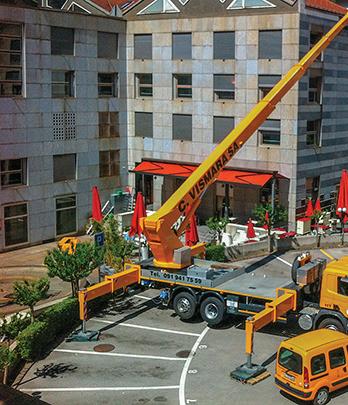
Rental: Why are not more design solutions supplied as standard?
Clark: It depends on what you’re talking about. Tony mentioned access decks. There’s a few manufacturers that have integrated that into the platform as an option but we buy it as a standard. So, the last few years at the manufacturer had it, we include it. It’s just that extra piece of safety that’s in the machine now. We know that it’s not removed. It’s not put on another machine where it could be reassembled incorrectly, or something like that. It helped standardize our rental fleet. We know this make, model, and model year all have that access deck. It depends on the customer and the application for everything.
Gildea: Adding to what Brian said, if you look at an innovative improvement that comes to machines or process, there’s a lifecycle to it. There’s the idea, then typically it’s going to be tried on existing machines first. Then it’s going to be adopted, maybe, in one geographic area or by one large customer that decides to take a chance on it and has success with it. You gain experience from a lot of different ways. Eventually, it gets refined and reaches the point where you have others working on the same idea. Standards are maybe towards the end.
The problem is that some machines lag behind and people say, “We have a successful solution, we’ve proven it on existing machines, customers are making it part of tenders and contracts, why isn’t it in the standard and required for every machine?”
I think that’s the point where the standards push other OEMs, make users aware of it, and for the people that need that nudge to make it more accepted in the industry and more common.

Lyons: Let me drive into that too, Kevin. Litigation is probably going to drive more of this change than standards, because litigation happens after the incident where standards can take 6-10 years to come through. I appreciate the comments about OSHA, that’s even longer to get a standard changed. But, if I’m a consultant and my client has an accident and I’m going to help prepare the case and I knew there was something safer in the field, my opinion would be, “well, if you didn’t use this machine, it wouldn’t have blown over in the wind because this lift was made to operate in the wind.” Those discussions are ones we rarely have until the attorney calls with a subpoena.
Gildea: That’s part of it. What I mean is that before it gets to the standards, some OEM’s have already embraced the idea and the safety early because that’s the culture of the company. Or maybe it’s required in another country first and then applied in the U.S. But when you get to the point that it is a requirement in the standard, then you’re just catching the lagging OEMs.
Rental: Nicholas, can you comment on how OSHA handles making safety innovations standards?
DeJesse: The federal rulemaking process is a complicated one. I say that based upon a few things. We take into account injury and illness trends. We have advisory committees in all industry sectors, whether construction, general industry or maritime. We discuss what we’re seeing in the field. We’re always looking at emergent hazards in all these industries as well.
Groat: If I take the question as “Why aren’t more design solutions made standard as equipment as opposed to accessories,” I’d ask what are the drivers to make the change? The first would be standards. If you came over and you put in a standard saying, “This must be on the equipment,” then they’re going to be on the equipment. If they’re not, it becomes a little bit more subjective. Next, I call it the golden rule: “the guy with the gold rules.” And generally, that means that the person who is going to be buying the equipment, the big users of the equipment—if they say, “I want this on the equipment” ultimately, the manufacturers are going to put it on the equipment. A good example of that for me was secondary guarding /belly bars. And a lot of the large users said, “We need something on this equipment” and all of a sudden, one manufacturer made it standardized and then everybody else followed shortly after. Sometimes it is the demand of the user saying, “This stuff better be on the equipment” and then it happens.
In a more pragmatic fashion, I would say that MEWPs are used by a wide range of industries, environments, and applications so the requirements for a construction site can be significantly different than a warehouse or a film set. Offering a base model with optional accessories, allows the customer to choose what they want. I think that you don’t have to put all the expense on something that may be rarely used, or sometimes can increase some of the impact of fitting those things up.
If you look at overload sensors. Some of the guys who were overloading it before, said I’d rather have the old machine than the new one because they weren’t concerned about killing a machine that was owned by the rental company. They wanted to put more equipment up in the air, quicker.
There are different drivers. Part of it is standards which are going to mandate that everyone’s going to do it and if everybody wants that. That’s the driver to make that happen.
Next is the users of the equipment. If they’re out there saying they want it, I’m going to say that the manufacturer’s obligation is to make sure that takes place. Those are the two greatest drivers, in my opinion, to making accessories standardized.
I believe MEWP manufacturers are hesitant to approve secondary suppliers’ accessories due to safety risks, compatibility issues, liability and legal concerns, warranty and support limitations, regulatory compliance, testing and quality assurance, and brand reputation. By maintaining control over approved accessories, manufacturers can ensure their equipment’s safety, reliability, and compliance with industry standards.
Rental: Does a safety design solution increase or lower liability?
Lyons: I’m going to go to hard hats. We know helmets unlike hardhats save your life. We don’t mandate those, but it’s the right thing to do for the individual. The second part of that is it can be a risk to a company that can’t afford to upgrade their equipment even though there’s a safer way to do it. That’s a very tough answer. That’s a risk management question they can’t answer because they don’t have the money to be safer.
Gildea: I think there’s different decision making approaches of different manufacturers when it comes to liability and whether to make a specific solution Standard or Optional. On the one hand, to make a good decision, you can say you need to understand the pros/cons of the option, the way the machines are used, the requirements in standards/regulations for this country and other countries around the world, what customers are requesting,, and what similar safety options are available on the market. In the end, you may say, for example, , “we’ve looked at these options, we’ve evaluated them and this safety option is better for one application, but it’s worse for three other applications so it should be optional” or for solutions that are proven to improve safety for the majority of applications, the decision making process leads to making a solution standard on every machine.
The decision isn’t always the same but liability becomes less of a concern because the approach to reach that decision was logical and consistent.
On the other hand, an OEM that doesn’t seek to understand the solution and then takes an approach that tries to “only make the machine as safe as it is required to be for a country” is not in a good position from a liability point of view.
DeJesse: It always is going to be the responsibility of the employer to provide a safe and healthy workplace, that includes asking is the person operating the equipment adequately trained? Are they trained, not only in theory, but also in practical terms in the sense of safe operation, understanding limitations and expectations of the machinery, and being able to exercise that knowledge in application and use. I would focus on operator training and its effectiveness.
Groat: Does it increase or lower liability? The answer is, yes, it does. It’s just that simple.
If you don’t have it, you should have had it. If you do have it, did you do all the right things. We talked about things that are not required but they’re out there—so why didn’t you put them on? And if you have something that you put onto it, did that have contributory issues to the effectiveness of it? Did it mitigate the risk properly? It’s like secondary guarding, it’s just that it’s secondary and it’s not going to prevent all crushing incidents. Even though a solution can mitigate, it doesn’t necessarily eliminate everything. I think that there’s that issue on the manufacturers in putting a product out there. Was it tested properly? Did you communicate how it’s used properly? Even in the user’s application of the device, the integration of it adherence to standards. If you’re a user of equipment, why didn’t you get that?
I think the issue is that you have both sides like with every risk assessment, you better have gone out there and done your due diligence to assess whether you’re mitigating the hazards appropriately or not.
Gildea: Tony makes a really good point about being clear about what the option or feature can do. What are the limitations? If you make claims that it’s going to protect you in all situations, then that could increase your liability because there’s an expectation that it works in a certain way, and it didn’t do it. I think you have to be clear; “I have a safety improvement [and] it’s good for this situation and this application, and here are the limitations. “

You don’t want to not implement an improvement because it doesn’t apply in every situation, there’s still benefit even if it’s only for some situations.
Lyons: Tied to that Kevin, too, is everybody’s listening for “what’s in this for me.” As an industry, if we can
prove it’s faster and more productive and more efficient and not talk about safety, people tend to follow that. People really don’t care as much about safety as we’d like to think. It’s all about profit and schedule. If we start forming opinions, and I started doing that, working three times faster from a lift than a ladder, people will pay more attention than being told it’s a safer thing to do and here’s the limitations of it.
Rental: Why is it difficult to get secondary supplier design solutions approved in this market?
Clark: There’s a there’s a lot of accessories that are available for all types of MEWPs. With our preferred partners, we would like to have their approval always to use whatever that device is. We don’t know if adding a screen around the deck on a boom lift is going to cause any wind drag. We rely on our preferred partners to authorize that solution or come out with their own solution so everybody is aware of the application and it’s approval.
Gildea: That’s exactly right. I guess, when I hear “approved” from a point of view of an OEM it means: will this change / modification to the machine affect the certification? The safety? Does it affect the assumptions that were made during testing? During design? Analysis?
Can the OEM still stand by the certification and safety of the machine after this modification is added? If yes, then the “approval” can be given.
Rental: How do design solutions affect the user’s perception of safety versus the hazard?
Gildea: I think in some cases, design improvements have progressed to the point where the risk is low enough that it’s not something that an operator is going to think about. Take hydraulic safety, for example. We’ve gotten to the point now where someone is not going to be afraid standing next to a hydraulic manifold or operating machine or a high-pressure hose. That could be a situation where they’re not concerned about that risk.
If we could get every risk on the machine to that point, then maybe—maybe—that’s not a bad thing unless you start to influence behavior significantly and the operator is taking risks they otherwise would not.
Lyons: I’d like to add from the construction side, how workers work. Kevin’s correct. If you have a scissor lift that’s safe till 35 miles an hour out in the wind, the workers will start using it between gusts. Number two, I think, perhaps it’s in U.S., we put together standards that shouldn’t be in place. For example, we have a standard right now for working on electrical equipment that requires you to wear arc protection. What that has done is putting workers in a place where they shouldn’t be because we have a standard in place.
I think this is a great question. We have to be careful with the standards we put in place that we’re not putting some of the onus on safety back onto the worker. In the case of this electrical standard NFPA, what we’re saying is you can do the work but you won’t get burned “so bad.”
Gildea: When you say “putting them in a place where they shouldn’t be,” you’re saying that the PPE gives a sense of security.
Lyons: Thanks, Kevin. In the U.S., when you cut your hands, we say, “let’s go up a cut level.” Instead of finding out what cuts your hands—we do PPE. Almost all the time…we focus on the worker, and protecting them versus eliminating the hazard up front. I had a guy cut his hand almost off cleaning out the inside of a duct. It was razor sharp. I called the firm up and I said, “Hey, can you deburr this?” [They said,] “Sure.” But I’m sure they yelled at that guy for not using the right gloves when we could have eliminated the hazard.
Groat: I think that design solutions are aimed at enhancing safety and reducing risk and preventing accidents, but they can lead to complacency.
I think MEWPs have increased in their efficiency and safety over the years to the point where some workers think that they’re inherently safe to do whatever they want to do when they’re in
Design solutions aimed at enhancing safety are crucial for reducing risk and preventing accidents, but they can sometimes lead to a sense of complacency among users. This phenomenon, where increased safety features can lead to a feeling of invincibility or reduced caution, is known as “risk compensation”.
If a design solution significantly improves safety, users may perceive the equipment as inherently safe, which could lead them to take more risks or neglect safety protocols. This is particularly true when safety features are highly automated or require minimal user intervention.
When users feel that design solutions have made a system extremely safe, they may become less vigilant about potential hazards. This reduction in alertness can increase the likelihood of accidents, as users may overlook risks that still exist despite the safety enhancements.
Even with excellent design solutions, a robust safety culture is essential. If the workplace culture does not emphasize the importance of following safety procedures, users/operators might develop a sense of invincibility despite the enhanced safety measures.
the equipment.
We did mention earlier, training is essential. Even with excellent design solutions, a robust safety culture is essential. If the workplace culture does not emphasize the importance of following safety procedures, users and operators might develop a sense of invincibility despite the enhanced safety measures that are in place. It’s like the Swiss cheese model, that many things have to go wrong in order for an action to occur. To be reliant upon one safety device I think is an improper assessment of safe use. The risk assessment takes everything into account.
When you’re looking at the task that needs to be done, that task needs to be done. If you’re using a ladder, or a scaffold, or a MEWP, each one of those has its own unique hazards associated with them: climbing up and down, assembling and disassembling, moving the guard rails, not moving the guard rails. When you get to the point where you end up having this great machine that has a full guardrail platform that will elevate you to the exact height, and it has all these features that we’re putting onto them, making them increasingly safe, but at the same time, it doesn’t eliminate all hazards, and risk.
I think that, you know, you need to make sure that people are aware of what the overall hazards are with all the tasks that are being completed. We need to make sure that while we’re talking about designing out hazards, I don’t think that we can totally design them out because we have human beings being human doing sometimes stupid things.
While I appreciate TJ’s perspective, which is we also can’t shift safety on the backs of the operator, because they don’t have control over a lot of the decisions. For me, it’s like proper selection of the equipment and the MEWP is being one of them but the accessories of the MEWP are another one of them. It’s the correct selection of the equipment isn’t just “this model MEWP,” but it’s “does it also need secondary guarding,” “does it also need all these other elements that are part of it,” “do they need a hardhat,” “do they need the gloves.” I think all of those are part of it.
Clark: I would flip that a little. I feel like secondary guarding has called attention to the hazard. Now the operator is aware that there’s a line or bar there. They have to put their hands in proper placement to use the machine correctly, or the disable the guarding and the machine stops. I truly believe that they’re a little more aware: “Hey, there is a hazard here, I need to look at my surroundings. I need to be careful when I raise / lower / drive.”
Rental: Nicholas, can you speak to the dangers of complacency?
DeJesse: Tony mentioned something really good, which is there’s a human element. And in that human element, , this is why we strongly encourage companies to develop robust safety health management systems. Which goes back to what was said earlier, training is foundational. If you’re building a house and you have
a basement, you pour the walls and you let those walls settle. If you start building on it too soon, usually that house will fall or cave in. That’s the way I’ve always looked at training as being the most fundamental, foundational element when it comes to setting workers up for success.
Kevin and others have mentioned the machinery, the secondary safety features and associated considerations –absolutely raises the level of awareness of what is around them [workers] or the potential for what is around them whether it is contact with an overhead line, whether that is collision warning sensors, cameras on some vehicles—not on a MEWP obviously, but some other things. All of these enhancements, , are really meant to point out and raise the level of awareness of the hazards that are in and around that area. The training aspect of it is definitely foundational.
Have we seen complacency in the past? Sure, everyone’s human. That tends to occur. But this is why it’s so vital as well that at the beginning of the shift, having that conversation with people out on the site to talk about, “This is what we’re doing. These are the tasks of the day. How are we going to accomplish this work and ensure that no one gets hurt or gets killed? What are the safety features?”
Additionally, I think we’re starting to see more employee empowerment now than we did years ago, in the form of “stop work authority.” Stop work authority comes in the form of

employees saying, “that’s not working out right now, something’s amiss, I’m not going to force the issue, let me take a break,” call someone else, get another opinion or at least get another set of eyes on the situation. Having that stop work authority gives the employee more engagement in the safety and health process and also enables them to understand. It says, “Hey, you don’t have to put yourself in danger to get a task completed. There might be another way to do it, there might be another solution.”
This connects to organizational culture--these are things that are intangible. To me, culture is the intangible. It is the collective values, beliefs, and norms of the organization. These are the things that you really focus on as an employer, that are so vital to your organization. Safety has to be one of those core values.
When safety and health is at the heart of an employer’s a core values, you shouldn’t see complacency. What you’ll see, is more folks engaged in the safety process, asking questions and being more inquisitive.
Groat: I would complement that, because some of these safety innovations that we talked about, you need to know how they work. You need to be able to inspect them to ensure that they’re working properly, because of you depending upon them and there there’s a mechanical breakdown on them – you have exposure that it’s not working.
I agree 100% with the perspective that with all of innovation, with all the equipment that we have proper training and knowledge is paramount to how these things are being used. And being used properly inspected, properly maintained, all of those aspects that that are critical to the user going home at the end of the day.
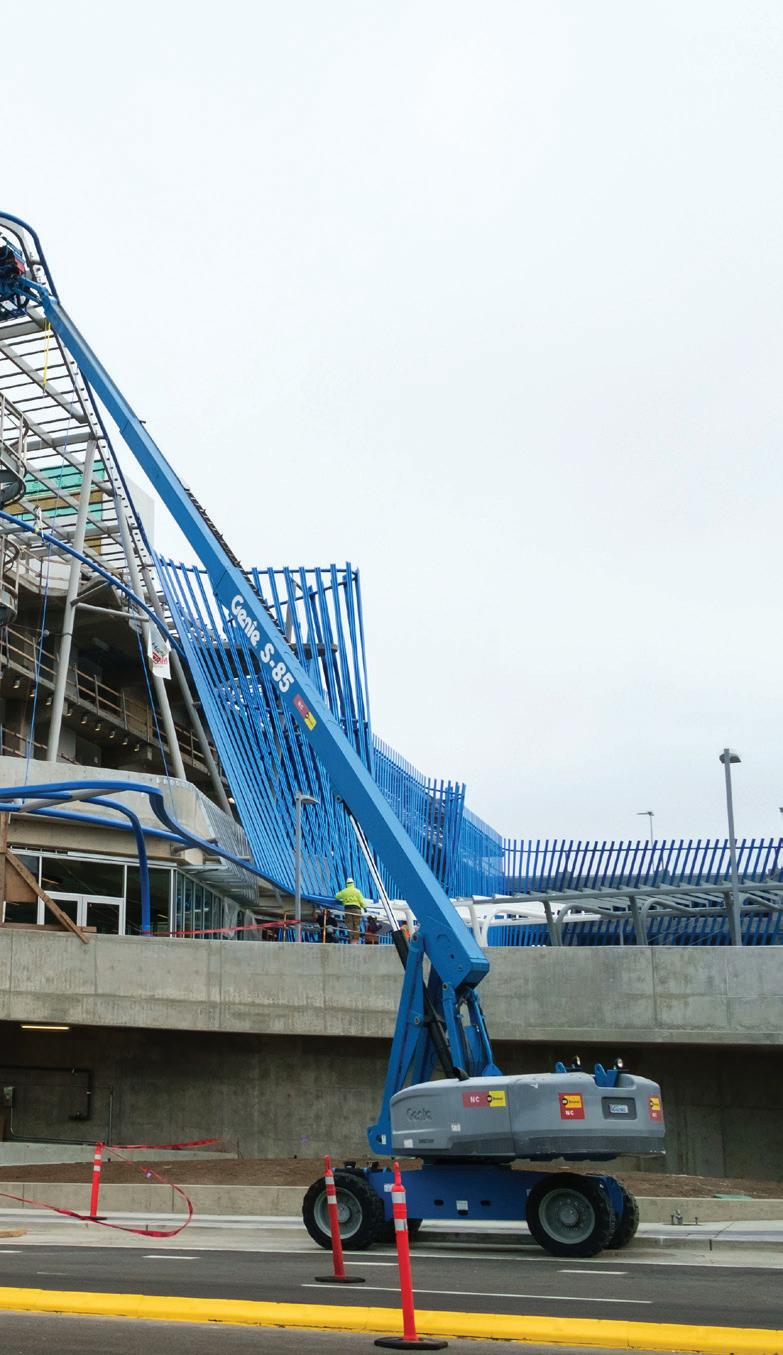
in the arsenal of safety to be implemented to ensure that the task is performed properly. But it is not the only one. It is a critical one and one that I think is the first one that we should be looking at. But again, when you put in place, you still need to train them on how to use it properly, still need to be able to train them to recognize what the hazards are to prevent those because no single device is going to protect someone, it is a combination of many things that are required to ensure a worker safety.
Gildea: There’s big improvements that can be made on the design side. It’s not the only tool in the tool belt, but that’s a big one. As I mentioned before, there’s things going on within the design itself that maybe aren’t apparent to the user, but it’s there and it’s moving forward. I think there are classic areas where OEMs are comfortable and experienced (electrical safety, hydraulic safety, structures, stability) and then there are other areas where improvements are made by applying new technology and by focusing on the users point of view and how the machine is used and incorporate that into the design. In any case, mitigating risk “by design” requires consistent, continuous improvement that is built into the normal machine development process.
Rental: To end, I’d like to ask our primary question once again. Can we design out hazards?
Lyons: That always has to be our goal, right? If you don’t design out the hazard, you have to trust that the worker will make the right decision if they have an option. I think we design out as much as we can so perhaps, they don’t have to make the decision to be safe or unsafe.
Groat: I think that it is a tool
SAFE
ZERO MAINTENANCE SUSTAINABLE HIGH PERFORMANCE
BRAVI PLATFORMS. RISE TO THE NEXT LEVEL
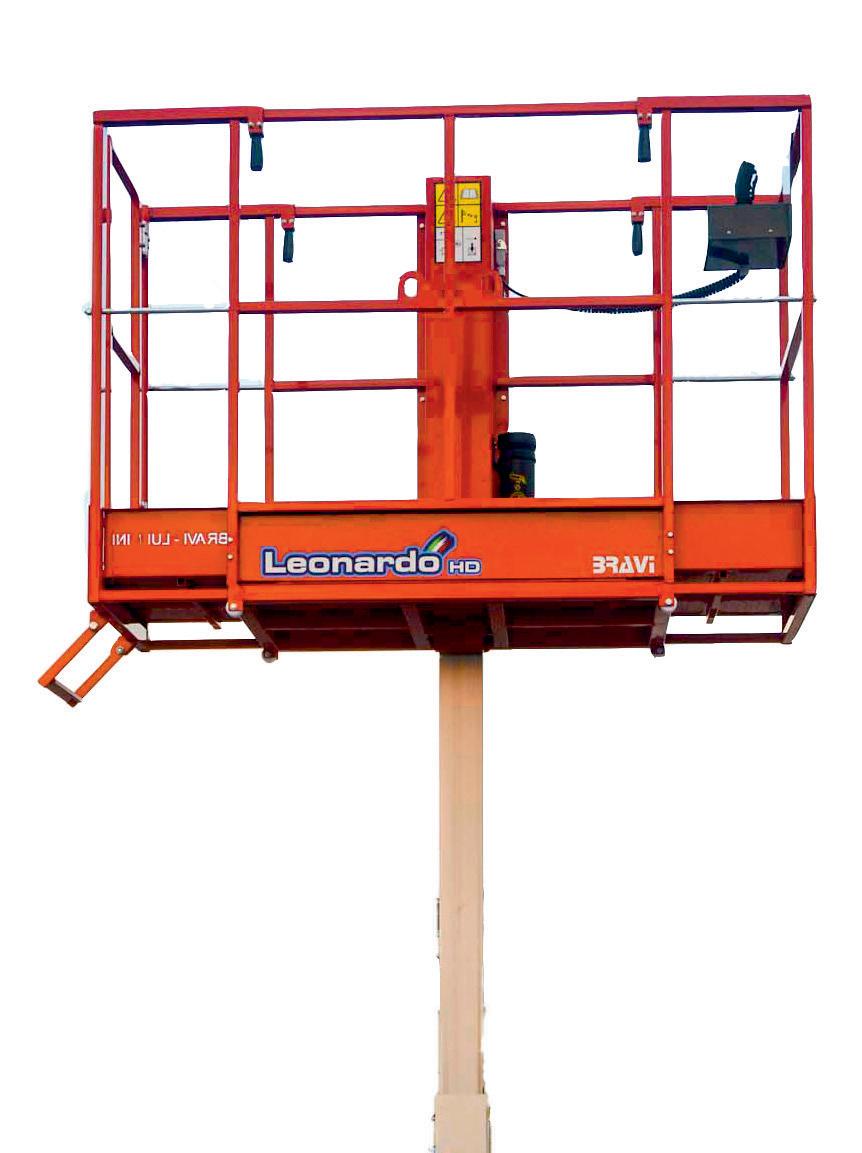
LEONARDO HD MOBILE PLATFORM




Size: 30 in x 47 in
Working Height: 16 ft
Load capacity: 397 lbs Unit Weight: 1234 lbs

Turning Radius: 0°

bravi-platforms.com
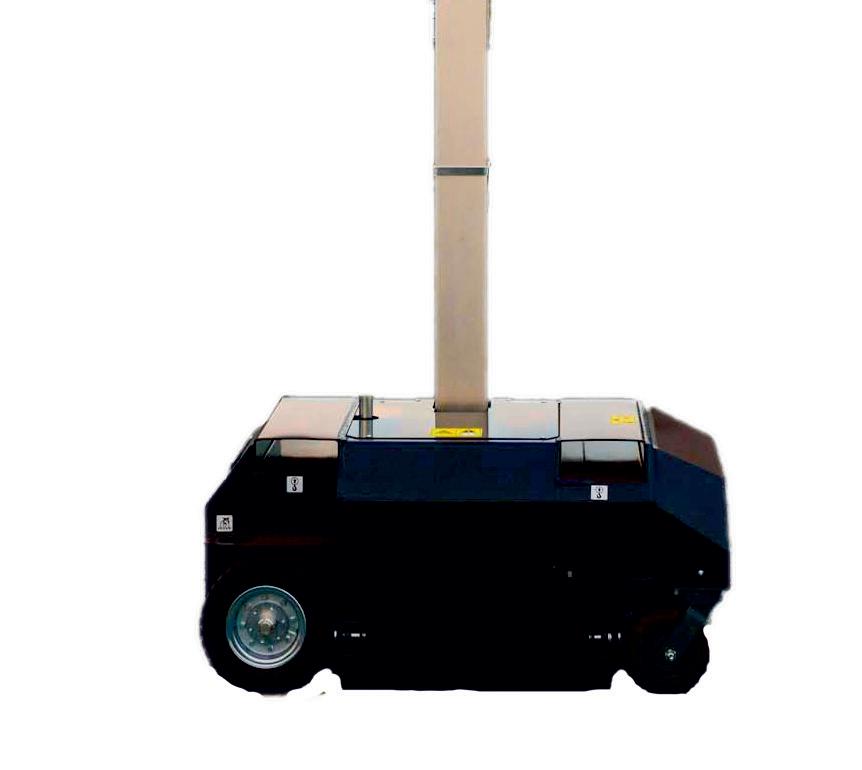

By Dave Swan, Senior Vice President, Trackunit


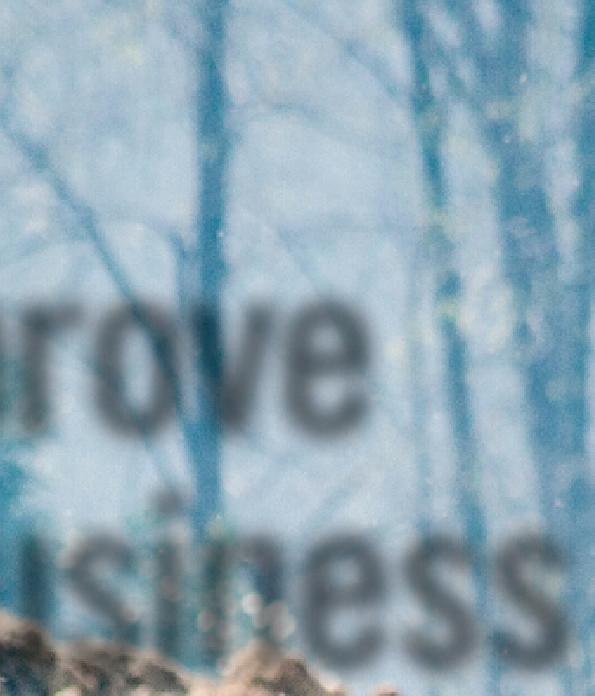
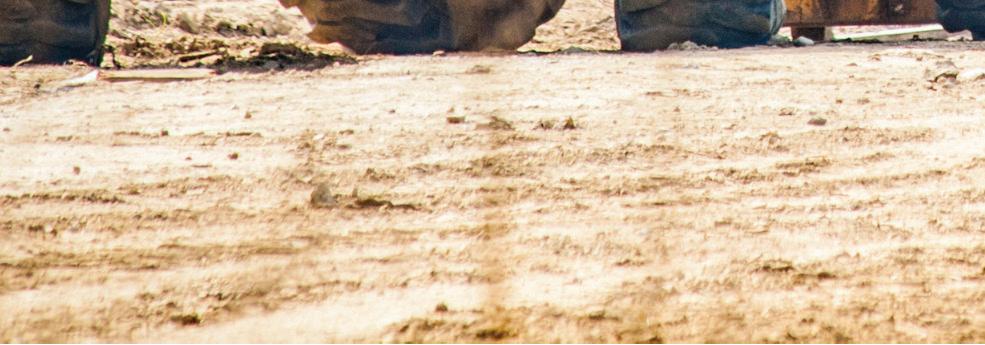
Investment in construction tech affects everything from the jobsite to the rental company office. The automation of manual tasks can reduce downtime on sites and help solve problems quicker. The ‘zero-incident’ construction site is now a realistic goal.
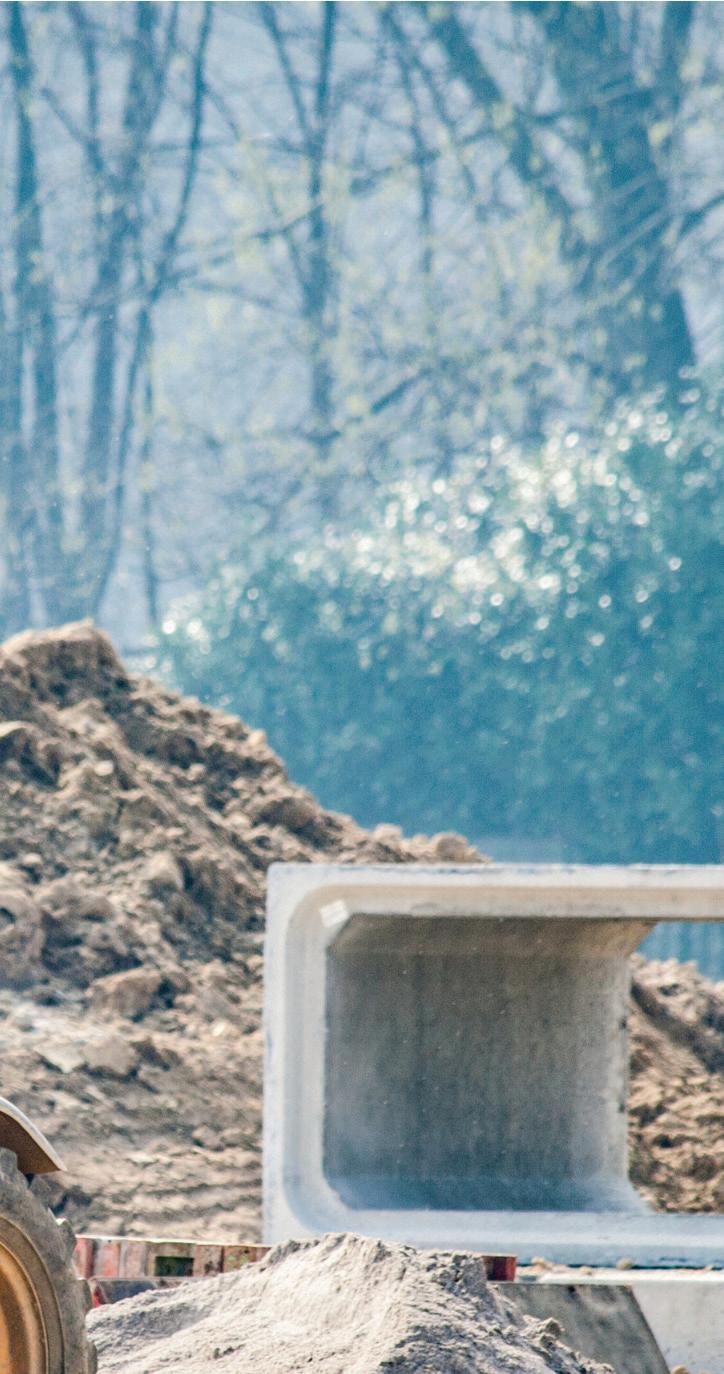
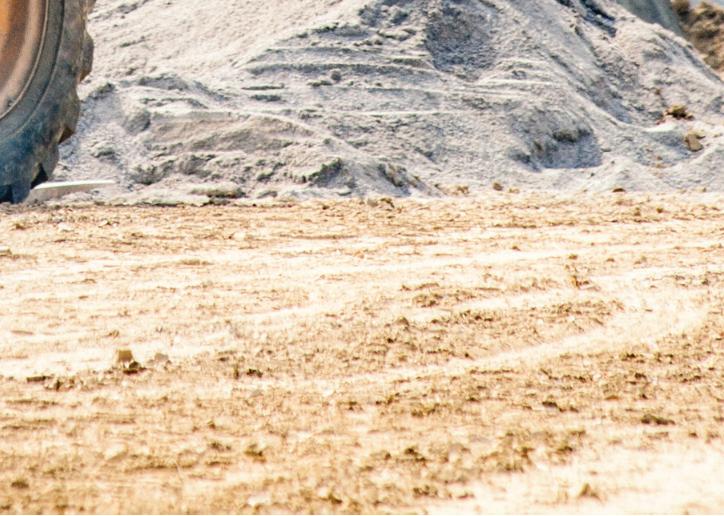
The requirement to gather data on site access management, equipment use, and emissions is becoming essential to rental and construction companies as well as legislators and investors, in efforts to variously increase man-machine productivity, improve safety, and reduce greenhouse gas (GHG) emissions.
Increasing pressure from government, investors, clients, and our industry is a clear indicator that reporting and leveraging realtime data on construction sites is becoming an essential baseline for contractors and the OEM and rental industry that support them. Live data tracking allowing meaningful insights to be delivered in real time is a major step in leveraging telematics to improve construction.
According to Berg Insights, the global construction equipment OEM telematics market will grow at a CAGR of 12.0% from 6.2 million at the end of 2022 to 11.0 million units by 2027. This demonstrates a healthy opportunity as customers demand higher machine efficiency and the evidence-based capability to prove the data they generate.
The wide variety of systems and their uses, together with increasing numbers of construction tech companies has brought a surge in the usage of portable and onboard technology onto the market. According to researchers at Future Market Insights, the construction tech market (globally) will grow to be USD 24 billion by 2033.
Construction and rental expect this investment to enable companies to rationalize their processes. Manual activities, such as maintenance schedules and individual machine faults should no longer be written down on paper, the automation of these tasks which includes images of machine parts or damage, is reducing downtime on sites and speeding time to solution, or replacement on sites and stockyards where this technology is in place.
In terms of construction industry priorities, safety is never off the table. And, with access management on the verge of a technological quantum leap, the ‘zero-incident’ construction site is now a realistic goal.
The growth in the International Powered Access Federation (IPAF) membership and ePal downloads indicates that there is an increasing desire among stakeholders to make construction as safe as possible. At the forefront of that discussion is zero fatalities, zero incidents, and zero-risk. Indeed, given what the industry is aiming for with the next step in access management, technology is helping to move the target closer.

is a Real-time Opportunity
Digitally linking access management, off-highway vehicles, MEWP equipment, tools, and the operator has created a realtime ecosystem, where a central resource links all these assets across the telematic network. Leveraging this telematic network to gather data from these various sources, allows us to process and analyze the information and generate reporting tools that provide for example, daily machine operating activity, realtime maintenance, or safety reports on individual or groups of machines, or operators.
It is important that the rental, construction partner, or the internal tech team developing the data solutions understand that data is a critical business asset. Leveraging data must start with the business problem and what data is needed to solve a problem or create the solution from an idea. This needs to be led from the top of the organization to ensure data solutions help drive business benefits. It must be understood that data needs to be accessible and usable by business strategists, not just technicians. Time-sensitive data has an intrinsic value and solutions need to be able to respond to alerts as they appear in order to achieve the most effective result, be that access denial, or contacting the operator with data they may need, e.g. reducing MEWP working height due to adverse weather conditions, over-revving while

the machine is idle, or supplying real-time fleet emissions to customers for use with customer or legal requirements.
It is often said that construction is slow to change because every new project is seen as an individual project, rather than a continuation of the construction operators’ business plan. In the digital world that is thankfully changing. Fleet owners and site managers can now leverage live data to build site-specific processes supported by digital dashboards allowing real-time overview of the site’s connected machines.
Trackunit’s Sites app is designed to offer efficiency to site
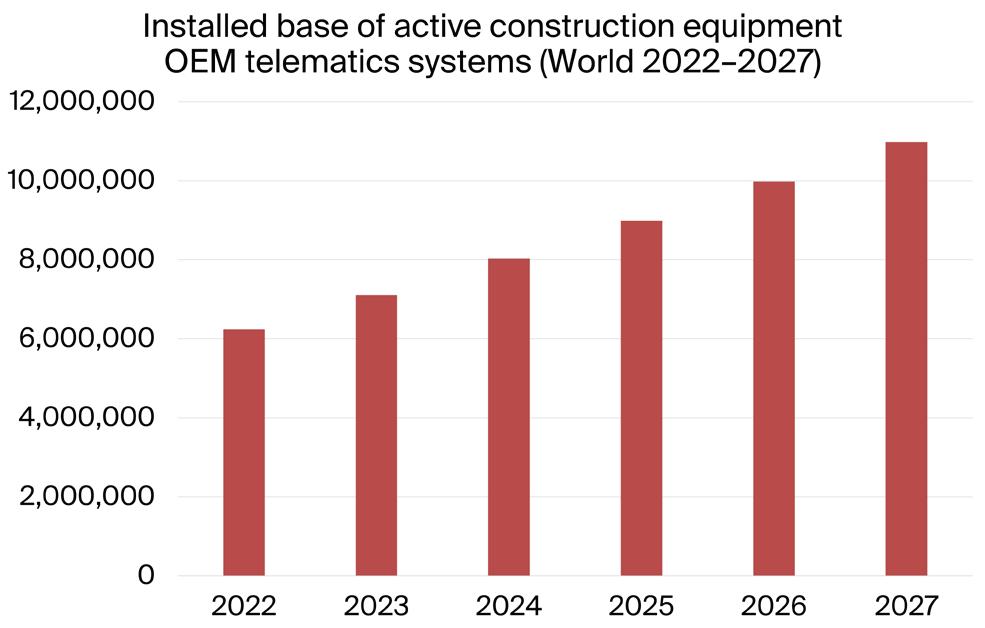

managers as it expands automatic detection of equipment status sitewide. Auto-grouping, preset alerts and reports generated by the machine’s arrival departure, and position on a site ensures users can integrate digital solutions and minimize manual administration of their fleet connectivity be that on a rental yard or construction site. For rental companies, the software in conjunction with telematics makes it much easier to see what is in their yard, where equipment is, and whether it is on its way out or in, saving time and increasing fleet efficiency.
With thousands of IoT devices joining networks every day in rental yards and worksites, the key to rental companies’ operational effectiveness is understanding the health of connected telematic devices. When devices or connections fail operators, fleet managers, and OEMs need usable data quickly in order to take remedial action.
The My Network app provides data, via Trackunit Manager, to quickly identify and resolve device-related issues to improve machine up-time and maximize owners’ return on investment. Whether an OEM, telematics program manager, rental or fleet manager, or service technician, My Network provides the data to reduce time to resolution by up to 75% using a self-service approach. This allows users to drive the usefulness of equipment data and increase the extracted value of their telematics solutions by 5-10%. Using real-time actionable insights users can drive continuous and proactive resolution of device issues 66% faster without the need for OEM or third-party support.
Leveraging three core aspects of the app users gain relevant data in a highly visual format, including, a complete overview of all important device KPIs to drive corrective actions, and configure thresholds, warning limits, and device types, depending on fleet requirements. Users can gain immediate visibility of the composition and distribution of the device installations from ten unique perspectives, driving operational value. Users can drill deeper into the device data with a consolidated list view of all
device-related information, with filters and sorting capability to highlight the devices that require immediate attention.
Leveraging and actioning the growing volume of data has allowed the construction industry and rental sector to take huge strides in the past few years. Investment in technology has been

a key driver in the rental market and has created a deeper understanding of the needs and benefits of data in a vehicle asset and business setting. This greater understanding has also extended the useful life of equipment, increased resell value, and benefited fleet valuations. Telematics, and the data it transports, continues to provide levers to implement more efficient processes, improve machine health, and helps increase safety and security across sites it is up to organizations and individuals to utilize the opportunities it provides. p
The International Powered Access Federation (IPAF) Summit 2024, hosted at the Scandic Hotel in Copenhagen, Denmark, was attended by more than 300 industry professionals. The event began with a heartfelt and thought-provoking speech by newly elected IPAF President, Karel Huijser. (Find his profile on page 36.) The presentations kicked off with an energetic joint effort by Amanda Tan, IPAF Asia Regional Development Manager, and Diego Bustamante, IPAF Latin America Regional Manager/North America Project Coordinator. Amanda and Diego, representing a new generation of leaders and introducing the summit theme of “Empowering the Next Generation”, highlighted the diverse backgrounds and global coordination within the IPAF team, spanning 14 time zones.
Attendance Was UP! Emphasizing IPAF’s commitment to innovation and safety, they celebrated a record-breaking year in 2023, issuing over 200,000 PAL Cards, signifying a 12% increase from the previous year. The ePAL digital app achieved over half a million downloads globally, with 62% of PAL Cards issued digitally through this platform. Additionally, key insights from the membership survey underscored the importance of safety, knowledge, and global collaboration within the IPAF community. Improvements. In 2024, IPAF plans significant enhancements, including improvements to the new IPAF PORTAL to streamline IPAF training center operations and digital testing options. Developments to the recently launched Customer Relationship Management system aim to improve member communications. The highly anticipated new Operator Course, set for release in late 2024, promises to revolutionize powered access training with its global expertise and innovative approach.
IPAF’s commitment to multilingual accessibility continues, with the current Operator Course available in 20 languages and test papers in 44 languages. The focus for 2024 includes expanding operations in China, Saudi Arabia, India, the U.S., and Canada, underlining IPAF’s dedication to promoting safety on a global scale.
AI Following the opening presentation, Daniel Hulme took the stage to delve into the realm of artificial intelligence (AI). With a diverse background encompassing roles such as Entrepreneur in Residence at UCL, Chief AI Officer at WPP, and CEO at Satalia, Daniel brought a wealth of expertise to the discussion.
Elaborating on data-driven decision-making, Daniel built upon the DIKW pyramid, inserting understanding between knowledge and wisdom. He explored the transformative impact of AI on business, inviting questions specific to the
powered access industry. Daniel’s presentation ventured into the philosophical aspects of AI, referencing Greek philosopher Socrates. He outlined six key applications of AI:
• Task automation: Macros, RPA, chatbots, and object recognition
• Content generation: Images, video, text, and music
• Human representation: Deepfakes, voice, and personas
• Insight extraction: Machine learning, data science, and analytics
• Decision making: Optimization, decision trees, and expert systems
• Human augmentation: Exoskeletons, avatars, and cybernetics
Highlighting the challenges of AI, Daniel emphasized concerns regarding security, safety, governance, and ethics. Recommendations included using AI for forecasting construction projects, risk assessment for account churn, and automating account management processes to enhance service. The session garnered significant audience engagement and thoughtprovoking discussion, with Daniel addressing a series of insightful questions.

Future-Proofing Rental. Joel Särkkä, Chief Information Officer of Renta Group Oy, explored future-proofing rental, focusing on Renta’s decentralized model, digitalization, efficiency, and sustainability efforts. Renta prioritizes intelligent fleet management, digitalized processes, and actionable data insights, enhancing customer solutions.
Joel elaborated on Renta’s vision to be the most sustainable and digital partner in the equipment rental industry, aiming to lead in circular economy practices and safety standards. They aim to mitigate environmental impact, excel in health and safety, and uphold responsible corporate governance.
Renta also emphasizes building capabilities to attract diverse talent and promoting employee well-being. Successful futureproofing leads to a more sustainable business, efficient operations, and increased rental penetration, ensuring better access to the workforce and talent retention.
Engaging the Youth. Kasia Gotlib, Senior Product Marketing Specialist at JLG, and James Hahessy, Product Manager of Connected Solutions EMEA at JLG, shared insights into engaging younger generations in the access industry. As millennials and new parents themselves, they highlighted the importance of reaching Generation Z and Generation Alpha, who make up a significant portion of the global population.
The duo stressed that the younger generation in particular favors teamwork, environmental awareness, and continuous learning. They seek investment from employers, open communication, and desire flexible working arrangements. Kasia and James stressed the need to empower and invest in existing talent while fostering a sense of community within the company.
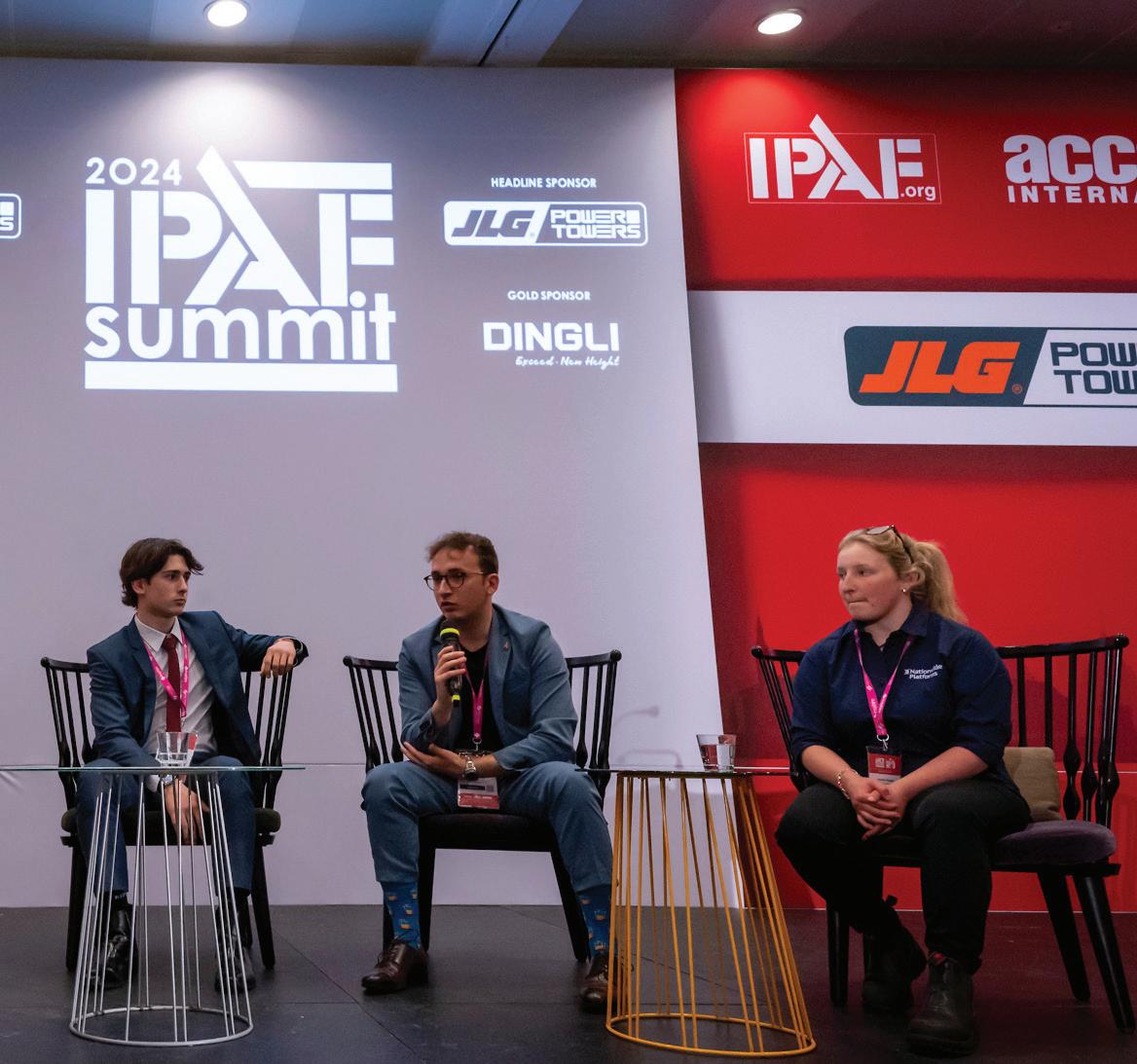
Their presentation resonated with JLG’s commitment to improving team engagement and communication, emphasizing the importance of conveying passion for the industry. While there’s no one-size-fits-all solution, increasing visibility on platforms preferred by younger generations is crucial.
Strategy. Ali Moore, Relationship Therapist at BeMoore, discussed strategies for integrating young people into the modern workforce and overcoming barriers. She explored the evolution of workplace relationships referencing IPAF’s inception in 1983 to the present day, highlighting shifts in values, priorities, and expectations. Identifying factors affecting young people entering the workforce, Ali addressed issues such as lack of experience, mental health concerns, and the expectation-reality gap. She advocated for creating a movement to improve company culture, offer competitive compensation packages, provide tailored inductions, remove biases in recruitment, and offering employees development opportunities.
Accident Cost. “Unlocking the Path to a Safer Jobsite” was presented by Chris Greenbank, IPAF Digital Marketing Manager, and Domokos Speeder, Vice President of Customer Success at Trackunit, highlighted the staggering €4.4 (roughly $4.88) billion cost of accidents on construction sites annually in Europe. They emphasized the need for innovation, collaboration, and adoption to address challenges like communication breakdowns and underutilized workforce productivity.
They cited the significant value created by companies investing in digital transformation, with digitally advanced firms outperforming their counterparts by 66%. Collaboration was underscored as pivotal, with leading companies leveraging partnerships to create synergies and alignment across ecosystems.
IPAF and Trackunit are actively collaborating to provide simplified certification management, seamless access to powered access machines, and effortless documentation, addressing complexities and safety concerns. This partnership, leveraging IPAF’s extensive user base of over half a million downloads and Trackunit’s ecosystem, aims to build a safer and more efficient jobsite environment.
In closing, Chris and Domokos demonstrated the unlocking of a scissor lift with the ePAL app via mobile phone, a feature launched in June 2024. The next phase of ePAL app updates will include the automatic completion of the logbook, scheduled for Q3.
Early Talent. In a presentation titled “Building a Workforce for the Future,” Holly Broadhurst, Senior Early Career Scheme Leader at JCB, discussed the company’s dedication to nurturing early career talent. Since its inception in 1945, JCB has acknowledged the significance of investing in talent, with numerous senior leaders commencing their careers within the company. In 2012, JCB revitalized its Early Career Talent (ECT) journey, incorporating graduates, apprentices, and undergraduates. By 2017, they aligned their schemes with government apprenticeship standards, optimizing their workforce for business needs.
Today, JCB focuses on proactively attracting, engaging, and inspiring talent alongside their forty apprenticeship programs. They employ various strategies, including STEM ambassador programs, virtual reality experiences, and targeted outreach to schools and universities. Moreover, they stress the importance of workforce planning, ensuring they have the right skills in place to drive growth and manage attrition effectively. Ultimately, JCB aims to develop a pipeline of talent equipped with the skills, knowledge, and behaviors needed to thrive in a dynamic business environment.
Safety Campaign. Brian Parker, Head of Safety & Technical at IPAF, and Alana Paterson, Head of HSE at Taylor Woodrow, jointly conducted a presentation at the IPAF Summit 2024, unveiling the upcoming Global Safety Campaign titled “CRUSHING CAN KILL!” Their presentation not only introduced the campaign but also delved into the meticulous monitoring of the success of previous safety initiatives. This approach reflects a commitment to continuous improvement and effectiveness in promoting safety within the industry.
IPAF’s focus on the new campaign on entrapment highlights a critical safety issue within the realm of powered access equipment. Entrapment incidents pose significant risks to operators and bystanders, necessitating targeted awareness efforts.
Scan the QR code for more on the “CRUSHING CAN KILL!” safety campaign.
https://shorturl.at/idA5W
Empowering the Next Generation. A thought-provoking panel session chaired by Karin Godenhielm, CEO of Dinolift unfolded, centered on empowering the next generation within the powered access industry. The youthful panel, comprising Joao Lourenco of Transgrua, Jennifer Roddis of Nationwide Platforms, Enio Navarro Vanzi of IPAF, and Thibaut Itzel of Genie, engaged in a series of insightful discussions.
Delving into topics such as industry dynamics, job-hopping trends, shared company-employee values, and entry barriers, the session offered valuable, forward-thinking perspectives. Notably, the engaging debate sparked considerable interest among older attendees, highlighting the relevance and impact of empowering the future workforce in the ever-evolving powered access industry landscape.
In concluding the IPAF Summit 2024, Peter Douglas, CEO, and Managing Director of IPAF, extended his gratitude to all attendees and speakers for their invaluable contributions to this landmark event held in the Scandic region. p
The International Awards for Powered Access 2024 (IAPAs) held on the evening of March 14 at the Scandic Hotel in Copenhagen, Denmark, showcased excellence, safety, sustainability, and innovation within the powered access sector. Organized jointly by the International Powered Access Federation (IPAF) and Access International Magazine, the event gathered over 420 attendees from across the industry to recognize outstanding achievements across various categories.
The evening commenced with a vibrant atmosphere as attendees gathered to celebrate the best in the industry. Following the completion of the IPAF Summit, which provided a platform for knowledge exchange and networking, the spotlight turned to the eagerly anticipated IAPAs ceremony.&
With a record-breaking 130 entries across 13 award categories, competition was fierce, showcasing the industry’s dedication to pushing boundaries and driving progress.
A panel of industry experts, including Vicki Allen, Managing Director of International Platforms; Dawei He, Global Sales and Marketing Director of Sinoboom; Elisabeth Ausimour, President of the Production Division at Manitou; Vipul Tilsian, Managing Partner of RentEase International,
India; and Pedro Torres, CEO of Riwal, evaluated each entry, ultimately shortlisting top candidates from around the world.
IAPAs 2024 Winners:
• Access Rental Company of the Year: Mills, Brazil
• Contribution to Safe Working at Height: Electroelsa, Italy – Parachute device
• The Sustainability Award: CTE, Italy – MP 20 Ev
• Digital Development Award: Kiloutou, France - YOUSE
• Equality Diversity & Inclusion (EDI): Dayim Equipment Rentals, Saudi Arabia
• IAPA Innovative Technology Prize: Trojan Battery Company, USA – AES batteries
IPAF Member-only Categories
• IPAF Training Centre of the Year: Speedy Support Services, UK
• IPAF Training Instructor of the Year: Jose Ramon Etxebarria Urrutia - Plataformas Daryat
• Mast Climbers/Hoists: Maber Hoist, Italy - Lift Shaft Hoist
• Scissor Lifts & Vertical Masts: Dingli – JCPT1612PA
• Self-Propelled Booms and Atrium Lifts: Niftylift, UKHR15 H2E
• Vehicle/Trailer-Mounted: Palfinger - P 280 CK Edrive
IPAF/Access International Lifetime Achievement Award Winners:
• Davide Palazzani & Ken McDougall
Reflecting on the success of the event, Peter Douglas, IPAF CEO and Managing Director remarked, “The IAPAs serve as a testament to the remarkable achievements and progress within the powered access industry. Congratulations to all the winners and nominees for their dedication and commitment to continual improvement in our sector. I would like to thank all our staff at IPAF and the Scandic Hotel for helping to make the Summit and IAPAs so memorable.”
As the curtains close on another remarkable edition of the IAPAs, the industry eagerly anticipates the next chapter of innovation and excellence. p
The International Powered Access Federation (IPAF) announced the launch of its Global Safety Campaign for 2024, titled “CRUSHING CAN KILL!” The third Global Safety Campaign released during IPAF Head of Safety and Technical Brian Parker’s tenure aims to raise awareness and reduce entrapment and crushing incidents involving mobile elevating work platforms (MEWPs), which have resulted in numerous fatalities and injuries over the past decade.
Led by IPAF’s Brian Parker and Alana Paterson, Head of Health, Safety & Environment at Taylor Woodrow & Chair of the IPAF International Safety Committee, the campaign emphasizes the importance of training, proper planning, and adherence to safety protocols when operating MEWPs and using pedestrian control mode.
(vertical lifts). While this is a significant shift from the previous data, IPAF is encouraged by new solutions coming onto the market for vertical-type MEWPs.
The campaign highlights common causes of entrapment incidents, such as poor planning, inadequate training, complacency, and equipment malfunctions. To mitigate these risks, IPAF advocates for task-specific risk assessments, the correct selection of MEWPs, training of operators, and documented practice/ rehearsal of rescue procedures.
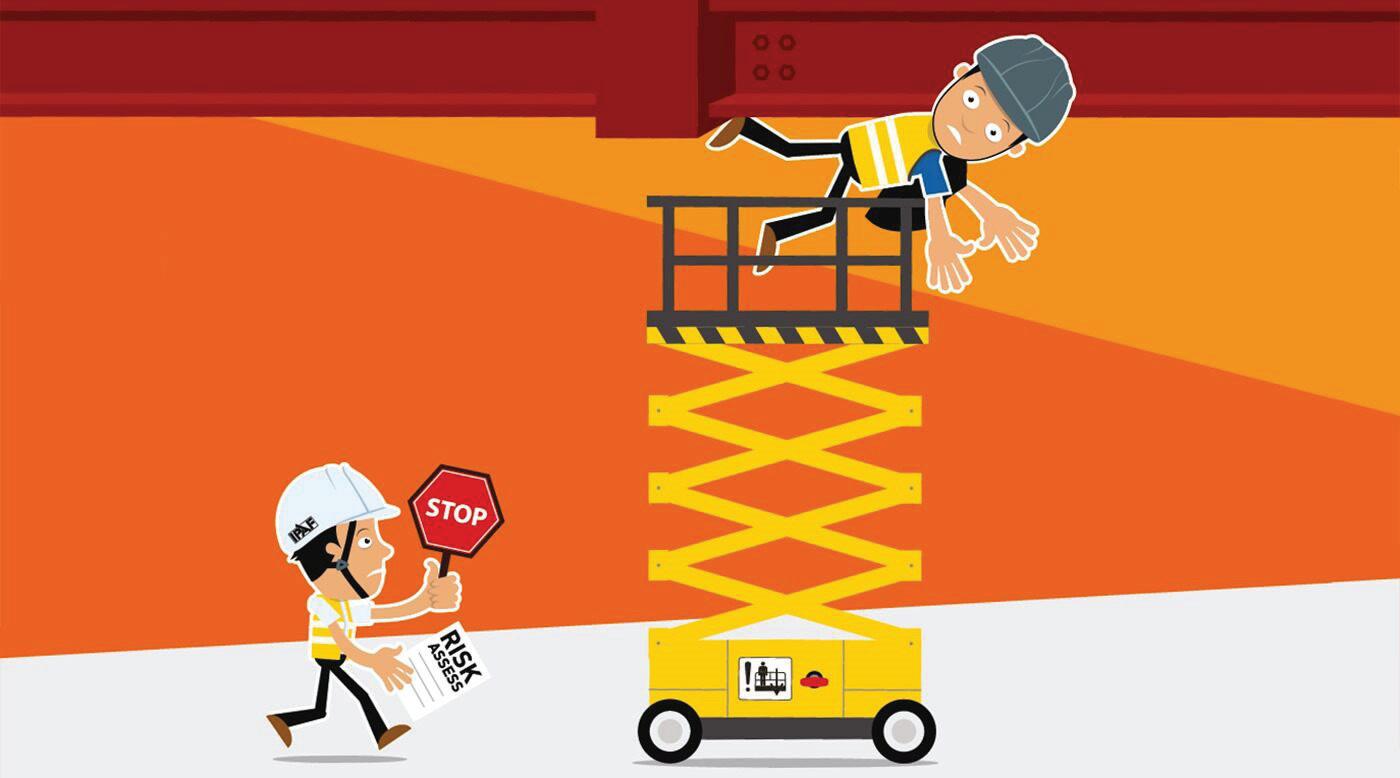
Statistics over the past decade revealed 118 fatalities, 16 major injuries, and 5 minor injuries attributed to entrapment incidents involving MEWPs. The occupations most affected include MEWP operators, delivery drivers, and technicians/ engineers, emphasizing the need for comprehensive safety measures across a variety of applicable industries.
In the last three years of fatal accident data, 68% of fatalities are attributed to 3a Mobile Vertical machines
Recognizing the global reach of the campaign, IPAF has developed legislationneutral guidance documents tailored for planners, employers, managers, supervisors, operators, rescuers, and training bodies. These resources aim to standardize safety practices worldwide and support the ongoing development of a new ISO standard for MEWP safety systems.
Additionally, IPAF has released a new Toolbox Talk focusing on the risks associated with operating MEWPs from ground controls with a persoan in the MEWP platform, as well as new industry-leading guidance on the safe use of pedestrian controls. An Andy Access poster titled ‘Danger Keep Well Clear!’ has also been developed to reinforce the
Toolbox Talk. These initiatives reaffirm IPAF’s commitment to continuously improving industry safety standards and reducing the incidence of entrapment and crushing-related accidents. Reflecting on the Global Safety campaign release, IPAF Head of Safety and Technical Brian Parker commented: “We’re not just launching a Global Safety campaign; we’re reaching out to the individuals who stand on the front lines of safety every day—the MEWP operators and rescue personnel. Our aim is to give them the knowledge and tools they need to navigate their work environments safely and confidently. By ensuring that this campaign resonates with those directly using the platform, we’re taking an important step toward reducing and preventing
entrapment and crushing related incidents.”
As the campaign launches, IPAF urges industry participation, implementation of recommended safety measures, and the reporting of incidents to facilitate ongoing safety improvements. Together, we can prevent and reduce entrapment and crushingrelated incidents and safeguard the well-being of operators and platform occupants in MEWPs. p
Scan the QR code for more on the “CRUSHING CAN KILL!” safety campaign. https://shorturl.at/idA5W
In a stride towards advancing technical education and meeting the demands of the rapidly evolving industrial landscape, a partnership has emerged between the International Powered Access Federation (IPAF) and ISI Rentas, an equipment rental agency in Monterrey, collaborating with Conalep, Mexico’s National College of Professional Technical Education. This partnership offers a specialised course: Programa Formación Técnicos PEMP (MEWP Technician Training Programme), tailored to meet the needs
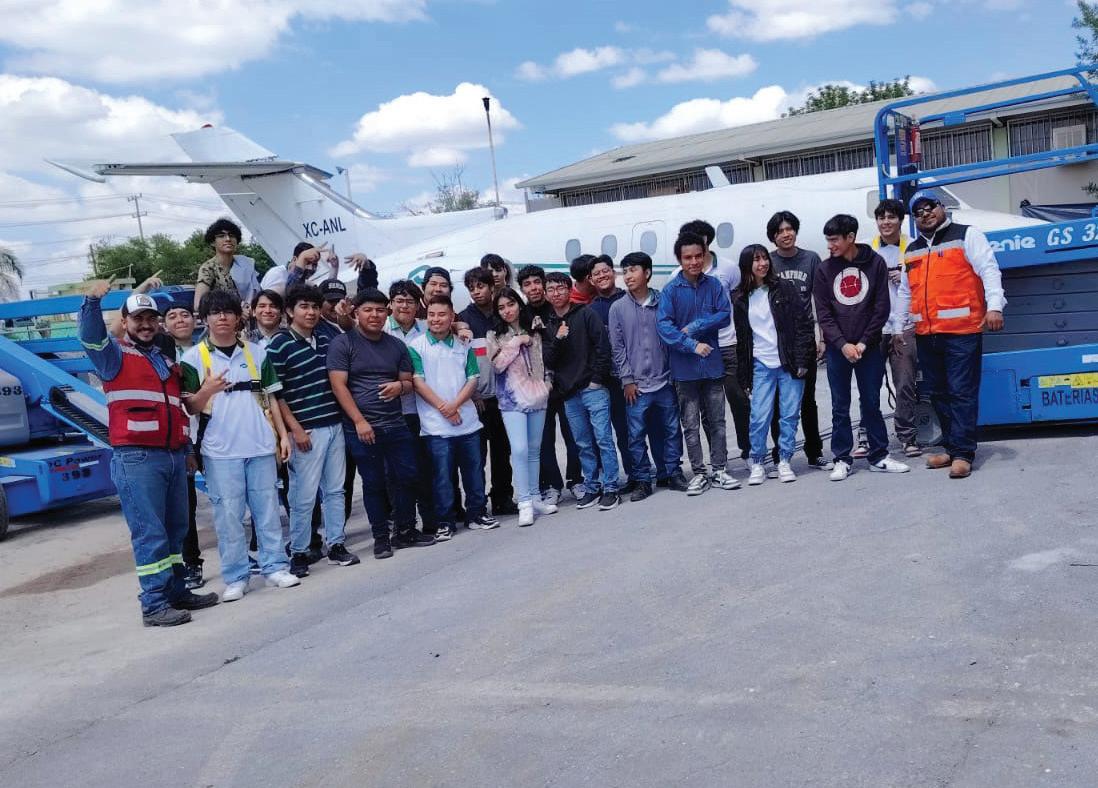
José Antonio Padilla Segura which provides technical training in Mexico. With a mission to produce skilled professionals through competency-based models, Conalep is renowned for providing high-quality education. Now, with the integration of IPAF and ISI’s apprenticeship program, Conalep students can
avail this unique opportunity to gain a recognized Technical Apprentice Level 1 qualification.
The syllabus and class components for Conalep students engaging in the IPAF x ISI Rentas apprenticeship program are designed to ensure a comprehensive learning experience. From classroom-based theoretical learning to practical handson training and innovative eLearning modules, students are equipped with the necessary skills and knowledge to excel in the powered access industry. Moreover, students who successfully complete the course will receive official certification, validating their proficiency and enhancing their employability prospects.
The course provides students with a comprehensive curriculum covering essential aspects of MEWPs, ranging from electrical materials to basic hydraulics and hydrostatic drives.
Central to the success of this apprenticeship scheme is the involvement of ISI Rentas, a Mexican company renowned for its commitment to safety and quality in machinery rental services. Their emphasis on transparency, integrity, and excellence resonates throughout the program, ensuring that students receive quality training.
The selection process for aspiring apprentices is rigorous, with emphasis placed on academic excellence and aptitude. Students undergo a thorough screening process, including an online selection questionnaire, before embarking on their journey towards becoming certified professionals in the powered access industry.
As the apprenticeship program unfolds, Conalep students gain not only theoretical knowledge but also practical experience through hands-on training with industry-leading equipment. By collaborating with leading clients, Rentas provides students with real-world exposure, preparing them for the challenges of the industrial landscape.
Diego Bustamante, IPAF’s Latin America Regional Manager & North America Project Coordinator, commented: “Through this partnership with ISI Rentas and CONALEP, we aim to empower aspiring professionals with specialized skills and internationally recognized certifications. This initiative not only benefits individual students but also contributes to the overall growth and sustainability of the industry in Mexico. We are proud to be part of this journey towards shaping a skilled young
Set for Nov. 19-20 in Nashville, Tennessee, the inaugural Working at Height Conference & Awards, jointly organized by the International Powered Access Federation (IPAF) and Access, Lift & Handlers (ALH) magazine, will place a spotlight on the utilization of aerial platforms to enhance site productivity and safety.
• Equipment rental managers and owners
• Safety professionals in the construction industry
• Access rental specialists
• Safety consultants
• MEWP OEMs and distributors
The day-long conference targets buyers and users of aerial platforms, encompassing rental companies and contractors. It will champion the safe and efficient utilization of mobile elevating work platforms through cutting-edge industry innovations, technology, and best practices.
Key Themes
• Keynote address from a prominent rental company executive
• Addressing safety and the human factor in height work
• Formulating emergency preparedness and rescue plans for height work
• MEWP accident statistics: A comparative analysis of the U.S. performance
• Panel discussion on technology’s pivotal role in height work, featuring industry experts exploring access control technology and leveraging data for safe machine use
• Panel discussion on Cultivating a safety culture
• Exploration of Training and technology, spotlighting the latest advancements in e-learning (benefits and constraints) and VR/AR training
• Guidance on selecting the right PFPE
• Insights into Exiting at height – ensuring compliance For further updates, visit workingatheightvevent.com. p
workforce for the future. This is just the beginning of what we hope will prove a showcase for our industry.”
IPAF and ISI Rentas’ apprenticeship program with Conalep marks an important shift in technical education in Mexico. By equipping students with specialized skills based on internationally recognized certifications, the program empowers students to thrive in the dynamic and competitive world of the powered access industry. p
Developed for users of powered access equipment, the International Powered Access Federation (IPAF) ePAL app has reached the milestone of 500,000 first-time downloads. The app was launched in June 2021 for operators of mobile elevating work platforms (MEWPs) and mast-climbing work platforms (MCWPs). Free and available in seven languages, it contains digital certification of training, including the IPAF Powered Access Licence (PAL) Card. It also allows sharing of safety guides and messages, logs machine use time and machine familiarisation, and can be used to report incidents and near misses.
“Reaching half a million downloads is a major milestone and a clear indicator that the powered access industry has embraced our digital approach,” said Peter Douglas, IPAF’s CEO and Managing Director. The app provides assurance that MEWP operators hold the right qualifications and helps to keep industry colleagues informed on safe working practices.
IPAF developed the app in partnership with member firm Trackunit. “Reaching the 500,000-download milestone for the ePAL app is a testament to our successful partnership and our shared commitment to improve safety and efficiency in the construction industry,” said Søren Brogaard, CEO of Trackunit.
“This is a significant leap towards our goal of eliminating downtime and promoting sustainable practices. We remain committed to our partnership with IPAF, focusing on innovation and continuous improvement for the benefit of the entire industry.” p

By Daniel O’Sullivan, Communications Manager, IPAF



When it comes to powered access equipment, safety stands as an uncompromising factor, essential to operational success. This commitment to safety is reflected in all that the International Powered Access Federation (IPAF) does. The IPAF organization is dedicated to promoting and enabling the safe and effective use of powered access equipment while developing a safetycentric culture through its dedicated Accident Reporting Portal: ipafaccidentreporting.org.
However, the necessity to prioritize the prevention of severe injuries and fatalities has become increasingly apparent. While non-fatal injury rates show a downward trend, the incidence of work-related fatalities has plateaued over the past decade, with a concerning rise in recent years. Currently, the fatality rate stands at 3.5 fatalities per 100,000 full-time equivalent workers, translating to an alarming 12-14 fatal occupational injuries each day.
In response, over the past several years, OSHA has
spearheaded a campaign aimed at raising awareness about the four primary hazards in the construction industry, aptly termed the “Fatal Four” or the “Focus 4.” These hazards—Falls, Struck-By, Electrocution, and Caught In-Between—align closely with IPAF’s exploration of six main incident types within its 2024 Global Safety Report. IPAF’s report delves into the causes of incidents and accidents, covering risks such as falls from platforms, overturns, electrocution, entrapment, MEWP/MCWP inoperable mechanical technical failure, and collisions with vehicles or machinery.
According to OSHA’s 2022 data:
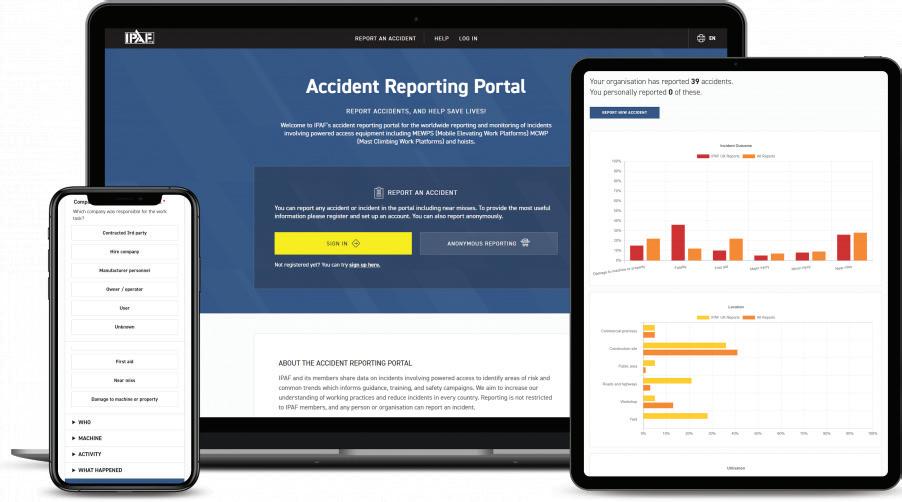
• 1,069 construction workers were fatally injured in 2022 in the U.S.
• Falls accounted for 38% of incidents
• Struck by accounted for 8% of incidents
• Electrical accounted for 6% of incidents
• Caught in-between accounted for 6% of incidents
At the heart of IPAF’s mission lies a belief in the transformative power of data-driven decision-making. Through its user-friendly platform, stakeholders worldwide are encouraged to contribute to a collective source of incident data. What sets this initiative apart is its inclusivity—reporting isn’t confined to IPAF members but extends an open invitation to individuals and organizations globally, with the option to also submit reports anonymously. This approach not only widens the scope of data collection but also helps provide a more comprehensive understanding of safety challenges across diverse industries and regions.
The significance of this collaborative effort cannot be overstated. By collecting incident data, IPAF and its stakeholders gain invaluable insights into emerging trends and common risk factors. This wealth of information serves as a guide for developing targeted safety guidance, training programs, and impactful global and regionalized safety campaigns. Through this process of data collection, analysis, and action, IPAF seeks to continuously elevate safety standards and practices within the powered access industry.
IPAF has embraced digitization as a means for enhancing accessibility and sustainability. The transition to digital platforms not only streamlines the reporting process but also ensures that safety information is always readily accessible to stakeholders. Central to IPAF’s safety initiatives is the annual release of the Global Safety Report—a comprehensive compilation of accident data from across the globe. This report serves as a testament to IPAF’s dedication to transparency and accountability, offering stakeholders a nuanced understanding of safety challenges within the powered access industry.
The 2024 edition of the Global Safety Report reflects both progress and challenges within the industry. Offering an overview of our latest findings, the report seeks to provide a clearer picture of the powered access industry. While there was a commendable 12.3% decrease in Fatal and Major incident reports compared to the previous year, this decline contrasts with a concerning rise in fatalities by the same margin, highlighting the persistent safety challenges we must collectively overcome. Delving deeper into the data, it becomes evident that the construction sector remains particularly prone to accidents, with nearly half of all incident reports concerning powered access equipment originating from this industry.
The journey of IPAF’s Accident Reporting initiative, spanning from its inception in 2012 to the present day, is marked by a gradual increase in reporting awareness. In 2012, IPAF received 288 reports from 10 countries. Fast forward to 2023, and the landscape has evolved significantly, with the number of reports increasing to 1,011 from 42 countries—a testament to the growing recognition of the importance of safety reporting.
Despite this progress, IPAF remains mindful of the potential for underreporting and acknowledges the need for continuous improvement in reporting practices. As the organization looks towards the future, it is committed to further expanding its global reach and enhancing safety coverage in collaboration with its network of valued members and the wider industry.
In conclusion, IPAF’s dedication to global Accident Reporting and safety is stronger than ever. By harnessing the power of data, embracing digital innovation, and encouraging collaboration, IPAF continues to lead the charge toward a safer, more secure working environment for all involved in the powered access sector. With each report submitted, IPAF takes another step closer to its goal of saving lives and helping families return home to their loved ones, one accident report at a time.
Scan the QR code to access the IPAF Accident Reporting Portal https://shorturl.at/WDgx4
By Tony Groat, IPAF North America Manager
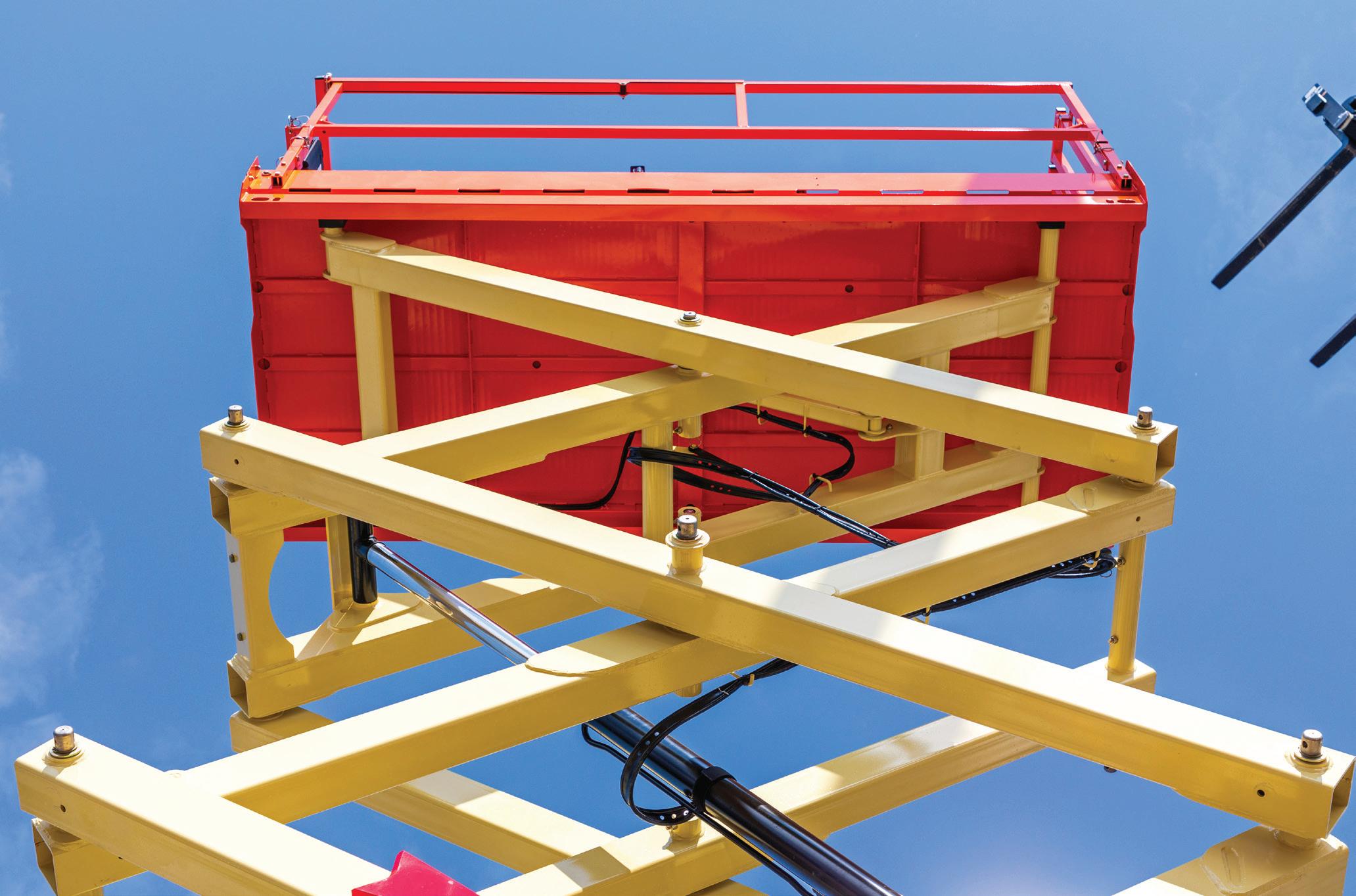
It is critically important that IPAF and its members continue to play a key role in the development of voluntary consensus standards for MEWPs.
As you already know, mobile elevating work platforms (MEWPs) are indispensable in countless industries to complete construction, maintenance, and various industrial tasks that require temporary work at height to be performed efficiently and safely. However, all work at height comes with inherent risks. These risks, and the hazards associated with these risks, are addressed and can be successfully mitigated through the development of comprehensive industry standards governing MEWP design, manufacturing practices, operation, and maintenance. IPAF and its members play a key role in establishing international standards developed by ISO (International Organization for Standardization) and National standards, such as those developed by the ANSI (American National Standards Institute) through the SAIA (Scaffold and Access Industry Association), along with Canadian standards developed by the SCC (Standards Council of Canada) through the CSA, (Canadian
Standards Association). These voluntary consensus standards focus on three key areas: design, safe-use, and training. Though the ultimate goal would be to have a single standard for MEWPs that would cover each of these key areas and accepted globally, the reality is that each region and many times even neighboring countries have laws, rules or best practices that do not align with a single standard approach. The result is having multiple standards on the same subject for the same machines. For this reason, IPAF staff and members have to be actively engaged in standards development work on many fronts. As they say, “it takes a village” and this is where IPAF, through its staff and member expert participation, and using its collective voice, can heavily influence the standards development process. Since the ultimate goal does not seem to be attainable, the realistic goal is to develop harmonized standards that establish the best standards requirements possible, both regionally and internationally.
Accomplishing this goal takes substantial financial and personnel resources which IPAF is committed to providing on behalf of its members for the long-term. It also takes IPAF member company involvement by providing the needed expertise to write these standards. Since IPAF staff have taken leadership and subcommittee roles with many of the standard’s bodies, they help advise, mentor, and guide members who want to participate in this important work.
IPAF North America staff currently are serving in the following leadership roles.
On ISO/TC 214/WG 1:
• Dan Moss serves as the WG 1 Secretary and Document Editor
• Tony Groat and Dan Moss also serve as subject matter experts for the ISO 16368, ISO 18878, ISO 18895, and ISO 21455 Projects.
• Tony Groat is the Project Leader for the ISO 18893 project.
On the ANSI/SAIA A92.22 and A92 Harmonized Definitions Sub-Committee: Tony Groat is serving as Chair. He is also a member of the A92.20 and A92.24 Sub-Committees. Dan Moss is a member of the A92.2, (aerial devices) A92.9 and A92.10 (mast climbers) as well as A92.20, A92.22 and A92.24.
On the CSA/B354 Committees: Tony Groat serves as the Co-Chair of the CSA/B354 Main Committee while also serving as the Subcommittee Chair of the CSA/B354.7 and CSA/B354.8 SubCommittee and a member of CSA/B354.6.
After dealing with appeals to address prior language identified as commercial terms violations by an ANSI Review Board, the latest ANSI/SAIA 92.20 MEWP design standard and ANSI/SAIA A92.22 safe-use standard was published on August 15, 2021, and became effective on the day of publication. ANSI/SAIA 92.24 (training) standard was published on December 20, 2018, but due to the appeals filed on the related design and safe-use standards, it did not become effective until June 1, 2020.
Typically, after a standard is published, ANSI requires standards to undergo periodic maintenance, defined as the review of the entire document and action to revise or reaffirm it on a schedule not to exceed five years from the date of its approval. Standard development work is NEVER done!
Currently, all three of these A92 standards are going through the maintenance revision process with hope that each will be submitted for approval vote this fall. If approved by the A92 consensus body, these standards will go through additional months of procedures to achieve final ANSI approval and publication. Each of these standards was essentially last edited in 2018 as later publications were limited to appeal language revisions. Also, the ISO MEWP standards are currently under revision, and they are the basis for the ANSI A92 standards. Good information sharing and proposal-making has been taking place between committees in hopes of aligning the documents.

Other ANSI/SAIA A92 Standards: USA
ANSI/SAIA A92.2, which covers vehicle-mounted aerial devices, was published in 2021 to address the same identified commercial term violation language across the A92 standards. With the 5-year clock always ticking, the standard is in maintenance with a plan for a revision in the coming years. A92.2 will remain independent of the A92 Suite of Standards (A92.20, A92.22, A92.24).
ANSI/SAIA A92.7, for airport support vehicles, was to be published several years ago, but due to the distraction of the appeals, its republication stalled. It is now under a new chair and will hopefully move to being republished in late 2025.
ANSI/SAIA A92.9, for mast climbing work platforms, was published in 2023. Shortly after publication, the A92.9 committee submitted a proposal to the A92 Main Committee to split the committee into two parts. This proposal was approved and now ANSI/ SAIA A92.9-1 will be responsible for developing a new standard covering the design aspects of MCWPs and ANSI/SAIA A92.9-2 will cover the safe use and training aspects of MCWPs.
ANSI/SAIA A92.10, for transport platform work platforms, was published in 2023. Similar to the A92.9 standard, the A92.10 committee submitted a proposal to the A92 Main Committee to split the committee into two parts. This proposal was approved and now ANSI/SAIA A92.10-1 will be responsible for developing a new standard covering the design aspects of MCWPs and ANSI/SAIA A92.10-2 will cover the safe use and training aspects of MCWPs.
The Canadian B354 standards went into effect in May 2018 and are adoptions of ISO MEWP standards for design, safe-use, and training, with added Canadian deviations. As adoptions of ISO standards, the CSA B54 committees are waiting for corresponding ISO MEWP standards to be republished before starting a review process on CSA/B354.5 (design), CSA/B354.6 (safe use) and CSA/ B354.7 (training). This review will likely be started in late 2024 or early 2025 after the ISO standards have been published.
ISO Technical Committee 214 (elevating work platforms) was formed in late 1996 to develop standards related to MEWPs as well as mast climbing work platforms (MCWPs). ISO/TC 214 currently has 19 Participating/voting (P) countries and 19 Observing (O) Countries actively engaged in its work.
ISO/TC 214 currently has nine published International Standards including:
• ISO 16368, Mobile elevating work platforms – Design, calculations, safety requirements, and test methods This standard was published in 2010 and was last reviewed and confirmed in 2021, making this version current. A new final draft is being processed and is targeted for publication in later 2024.

• ISO 16369, Mast-climbing work platforms (Under study. Potential revision to better align with ANSI A92.9 and other regional standards.)
• ISO 16653-1, Mobile elevating work platforms – Design, calculations, safety requirements and test methods relative to special features – Part 1: MEWPs with retractable guardrail systems (Intention is to withdraw this standard once ISO 16368 is published as the requirements have been incorporated into ISO 16368.)
• ISO 16653-2, Mobile elevating work platforms – Design, calculations, safety requirements and test methods relative to special features – Part 2: MEWPs with non-conductive (insulating) components
• ISO 16653-3, Mobile elevating work platforms – Design, calculations, safety requirements, and test methods relative to special features – Part 3: MEWPs for orchard operations
@bannafarsai.stock.adobe.com
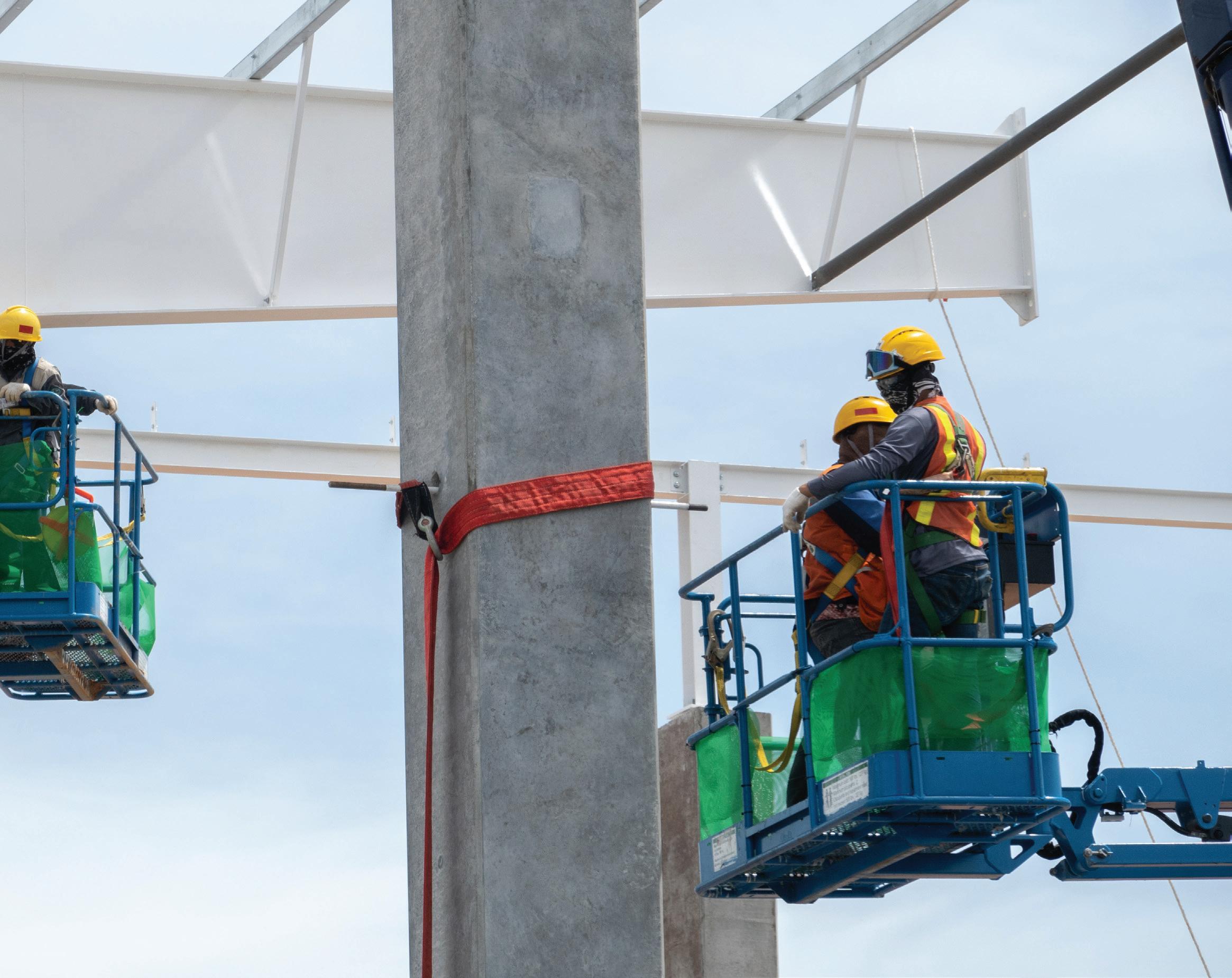
• ISO 18878, Mobile elevating work platforms – Operator (driver) training (New revision to be published in early 2025.)
• ISO 18893, Mobile elevating work platforms – Safety principles, inspection, maintenance, and operation (Final draft being processed. Should be published in late 2024.)
• ISO 20381, Mobile elevating work platforms – Symbols for operator controls and other displays
• SO 21455, Mobile elevating work platforms – Operator’s controls – Actuation, displacement, location, and method of operation
ISO/TC 214 currently has one proposed project:
• ISO 24995, Mobile elevating work platforms – Overhead obstruction detection systems and secondary guarding (2nd new proposal to be submitted by Standards Australia in May 2024) p
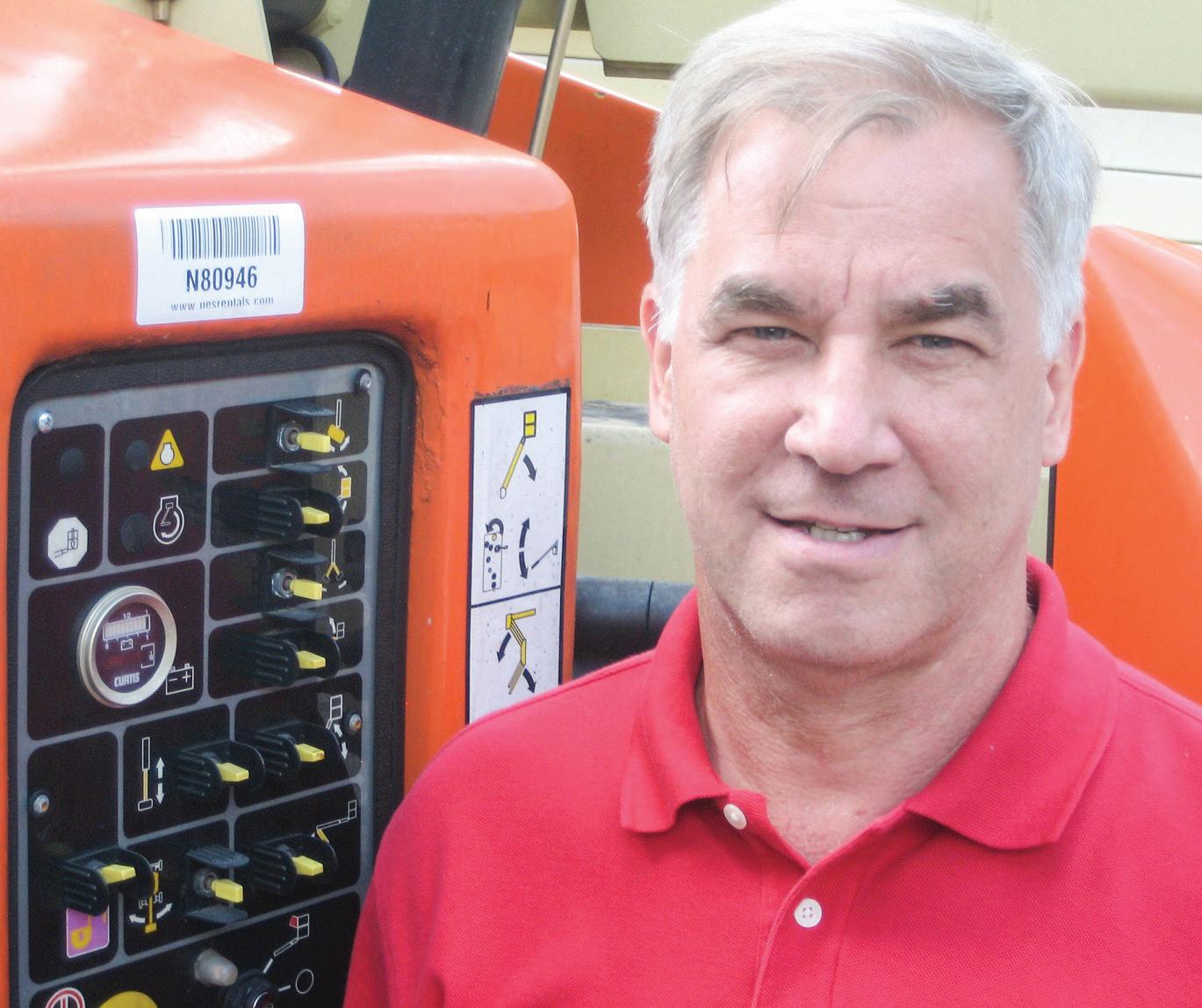
By Jonathan Kozlowski, Editor, Rental Magazine
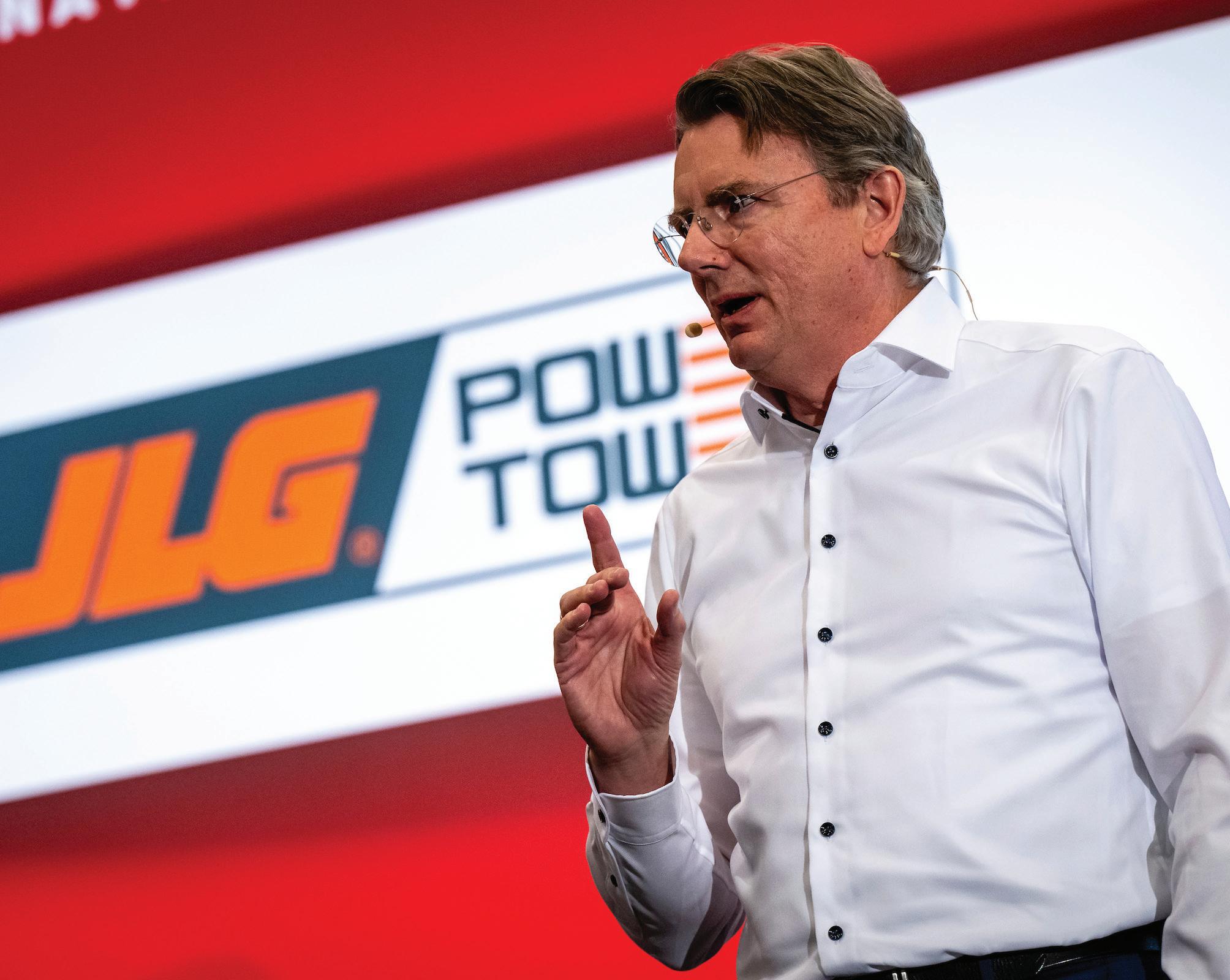
Q&A with Karel Huijser, IPAF President and General Manager for the EMEAI region at JLG.
Karel Huijser serves as the General Manager for the EMEAI region at JLG, a position he has held for nearly 12 years. His involvement with IPAF started through his leadership role and continued. For him, all players in the industry, make a difference in the lives of those who operate and service the company’s products and solutions.
After returning to school at 50 and attending a university in uptown New York City, his master’s in value-driven leadership led Karel to the Oshkosh Corporation and subsequently to JLG finding that his values matched those of both companies well.
Rental: Why the access equipment industry?
This industry, like my company, embodies admirable values. Beyond business goals, our central mission is to ensure safety for the end-users of our products and services. As an engineer by trade, it’s a great product to work with and an industry to work in.
Rental: Can you share some favorite stories from your 12 years at JLG and working with IPAF?
Back in 2014, I had an encounter with Brian King at an IPAF Summit in the UK. We hit it off by chatting about the amazing
company he and Mark Robinson had built. Fast forward a year, we acquired their company. In 2020, amidst the chaos of COVID and under the new leadership of Jonnie Dawson, we proudly opened a brand-new factory. Our first M&A move since Oshkosh acquired JLG in 2006. That acquisition reignited our M&A spark, and we’ve been on a roll ever since. Bringing Hinowa into the fold a couple of years ago, a stellar company we’ve had a fantastic 12.5-year relationship with, and, as you might have noticed, we recently announced an exciting merger with AUSA, another great company we’ve partnered with for some years already.
Another story is about a lively debate with my four millennial kids. As usual, they ganged up on this boomer, grilling me about our responsibility for the planet. But when I brought up the circular economy and pointed out that our industry has been a sharing industry for many years—long before sustainability became a buzzword—they were stunned into silence. They were even more impressed when they learned that electrification has been a top priority in our industry for decades and will remain a top priority for all.
Rental: What has been your journey with IPAF so far?
It’s been fascinating. I was introduced to IPAF by the Past President, Wayne Lawson, and joined the council, which is clearly the heart of the organization. With Peter Douglas leading the Federation, it’s an honor and pleasure to be the current president. One of my wishes is to build an even stronger relationship among IPAF, the ERA, and GRA, which has already been strongly improved since Peter took the CEO role.
Rental: What challenges have you faced and how have you overcome them? We’ve faced numerous challenges, including the pandemic, the invasion of Ukraine by Russia, and some economic setbacks. Personal tragedies also struck, with one employee heavily injured and another fatally injured—both were top service people and well-known in the industry.
You don’t overcome losing people. We can only be aware of our strong responsibility for safety and make sure we all do everything together to avoid accidents. Overcoming economic setbacks is a totally different story. In the 12 years I have seen it, the market always bounces back.
Rental: During the pandemic, I understand JLG started an email initiative using the #HappyMonday hashtag. Is this still going on?
Yes, it’s still going strong, with over 200 #HappyMonday emails. It’s a way to start the workweek on a positive note, in contrast to TGIF (Thank God It’s Friday). I write these emails at 9 AM every Monday, focusing on various topics from business updates to inspirational quotes of famous writers or leaders.
Rental: What did you learn?
While people initially thought it unusual, they soon began sharing personal advice about situations they wouldn’t normally discuss. This led to conversations I had never had before. Understanding that not everyone reads all memos, I started hash-tagging the subjects in the email titles to pique interest and encourage people to read them.
Rental: How can IPAF members integrate a similar program at their companies?
By simply starting it. Realizing that it’s a commitment every week, you can’t skip a Monday. Thinking about the Happy Monday message helps me plan for the week ahead, enabling a strong start, hoping it inspires others to do the same.
Rental: You’ve said, “Safety not only concerns today but also the future,” calling it “sustainable safety.” Can you expand on this?
Safety is a daily commitment in our industry. We must remain vigilant every day. Sustainable safety involves continuously sharing our successes and failures to learn and improve.
Rental: Are there any differences in the approach or issues regarding MEWP safety in the US vs. worldwide?
Safety is a global purpose. Some countries have stricter legislation than others, but in the end, everybody around the globe puts safety first. IPAF wants to play a supporting role and is finding its way in the US. Some see IPAF as competition, yet we should find a way to collaborate in this journey to make our industry safer every day.
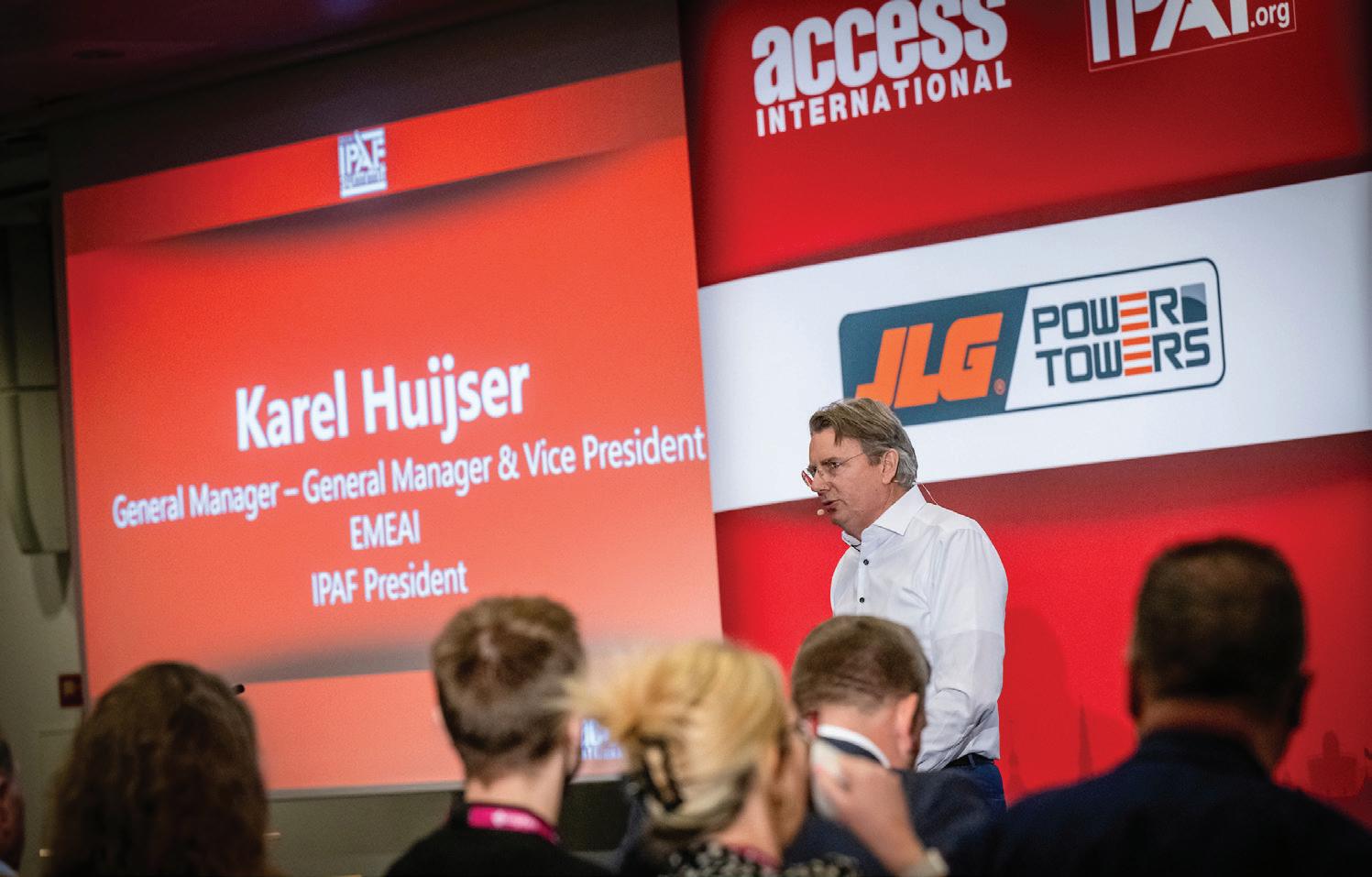
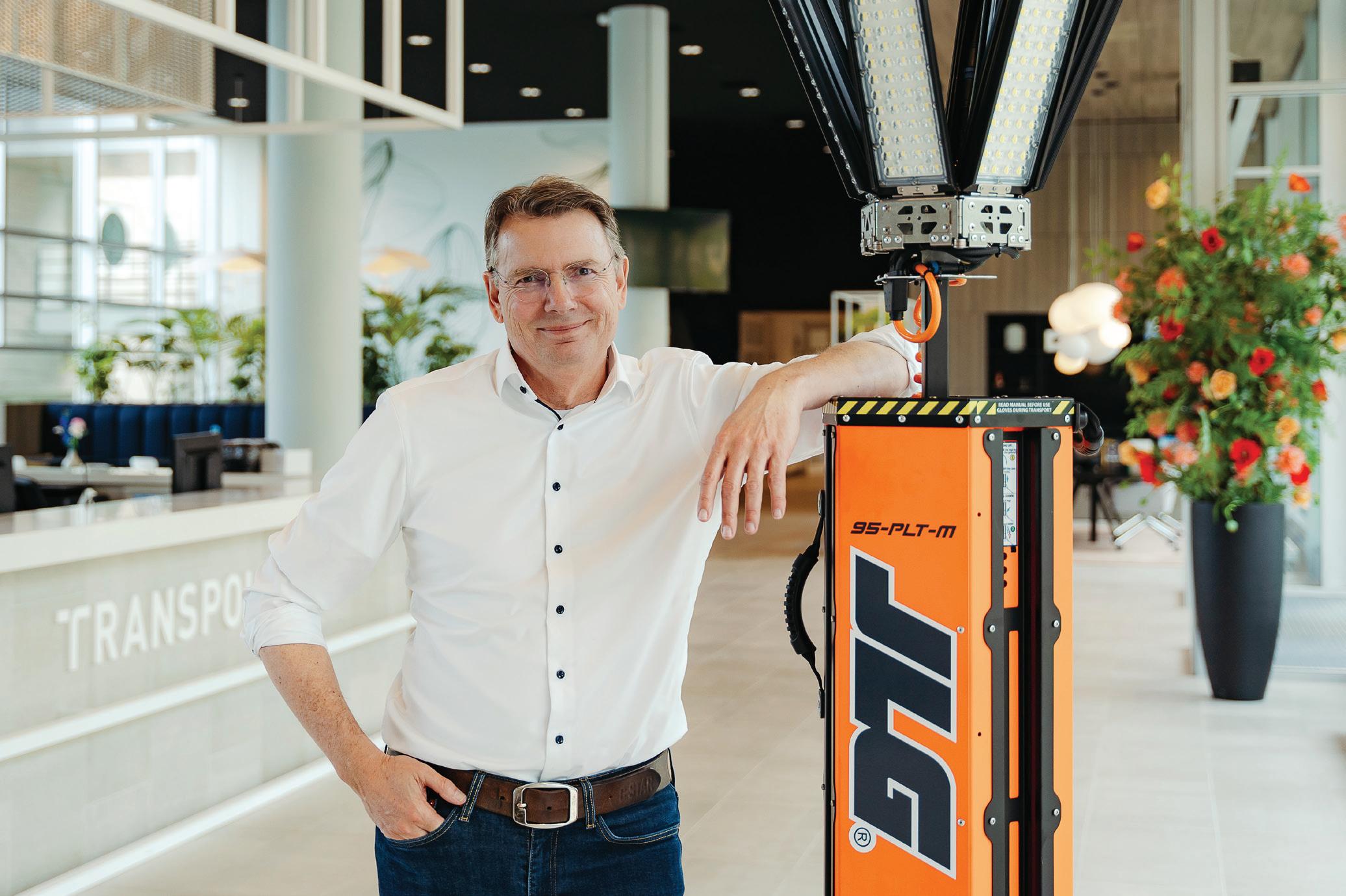
Rental: What is the current status of the Women in Powered Access initiative? What has been the outcome of the initiative thus far?
Our immediate past president, Karin, continues to lead this initiative. I’ve supported it by sending an all-female delegation to the IPAF Summit in Berlin a year ago. I believe that diversity through inclusion is crucial for success. We will continue to support the initiative, ensuring it is not dependent on having a female president. It’s good to embrace diversity. We must also focus on the next generation, as millennials will soon lead this industry.
There have been great sessions and high-quality presentations by women. In Berlin, we had speakers like Jay Iyengar, Oshkosh’s Chief Technology Officer, and Susan Xu, CEO of Sinoboom.
Rental: What advice do you have for people starting in the industry? Enjoy your job and embrace our mission of bringing people home safely.
Rental: What do you think IPAF members can do to bring more youth to the industry?
Share our story. Our industry’s strong mission around safety and inspirational purpose should attract young, open-minded individuals. Also, our sustainability story, which I talked about
earlier, is a strong one. If I can convince my own kids, we should be able to convince more millennials and even Gen Z to embrace our Industry.
Rental: What are your goals for your term as IPAF president?
• Inclusion & Belonging: Continue the focus on diversity and inclusion
• Storytelling: Emphasize sustainable safety by sharing stories of both success and failure to learn and improve
• Globalization: Expand our presence outside the UK, with a focus on China, the U.S., India, and Saudi Arabia
Rental: What will IPAF’s key initiatives be going forward?
• “Crushing Can Kill!” Worldwide safety campaign
• Digitization of IPAF’s training systems
• Launch a new operator training course by the end of 2024
• Further develop the ePAL app for enhanced functionality
• Achieve more than 50% of IPAF’s revenue from outside the UK in the next two years
By sharing stories about safety and focusing on global expansion, we aim to raise awareness and enhance safety standards every day. p
By Daniel O’Sullivan, Communications Manager, IPAF


Join IPAF today and elevate your business!

Become a member of the International Powered Access Federation (IPAF) and unlock a wide range of exclusive benefits tailored to elevate your business to new heights.
• Comprehensive Training: Access MEWP operator theory training and MEWP supervisor online eLearning courses ensuring your team is equipped with the latest industry knowledge.
• Networking Opportunities: Connect with leading experts in the MEWP and MCWP industries, fostering valuable relationships and staying ahead of the curve.
• Expert Consultation: Enjoy immediate access to MEWP technical experts, helping you tackle challenges and find solutions without breaking the bank.
• Stay Compliant: Understand your responsibilities regarding ASNI A92 and CSA B354 standards with access to standard chair and committee members for invaluable guidance.
• Advocacy: Have your voice heard in industry regulations and standards development, ensuring your priorities are represented.
• Market Insights: IPAF members that fall under the category of rental companies, manufacturers, dealer/distributors and suppliers can claim a complimentary MEWP rental market report, offering invaluable insights into market trends, utilization, rates, and growth.
• Professional Development: Access free, ongoing webinars covering timely topics crucial for professional growth, from managers to operators.


At top, over 320 people from across Latin America attended IPAF ElevAÇÃO (Elevation) event, held in Itapecerica, Brazil from May 8-9, 2024. Above, sponsored by JCB Access, part of the IPAF and IAPA 2024 summit from March 13-14, 2024, the welcome networking reception was held at the Copenhagen Planetarium.
• Safety First: Leverage IPAF’s decades of accident reporting data to enhance hazard awareness and improve workplace safety.
• Invest in the Future: Support the non-profit mission of IPAF in promoting safe and effective powered access equipment use, contributing to a safer industry for all.
Don’t miss out on these exceptional benefits… Join IPAF today!
Scan the QR code to find more on becoming an IPAF member.
https://shorturl.at/aerlA